49 Types of Oak Trees (with Pictures): Identification Guide
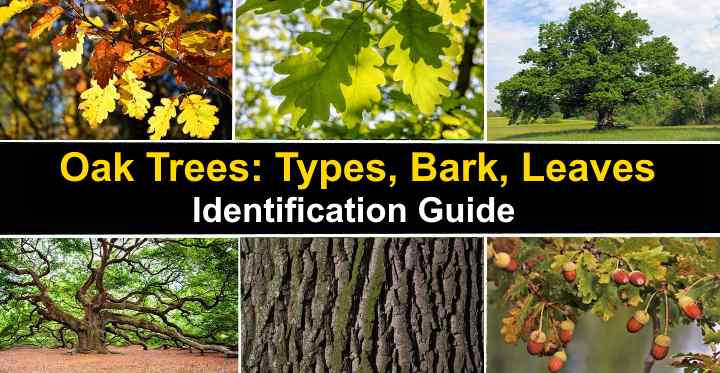
Oak trees are a group of hardwood trees that belong to the genus Quercus and the beech family, Fagaceae. All types of oak trees are categorized into two groups: white oak trees, and red oak trees. To identify the type of oak tree, you need to look at its bark, leaves, acorns and its general shape.
Oaks are among the most prevalent tree species in temperate regions of the Northern Hemisphere, gracing forests and parks with their majestic presence. Renowned for their elegant stature and sturdy hardwood, oaks hold a special place in landscapes.
Whether you’re looking for the perfect oak tree for your garden, this article can help you make the right choice. If you’re aiming to identify oaks in the wild, it will also guide you in recognizing these remarkable trees.
Oak Genra
Oak trees belong to the genus Quercus, a diverse and widespread group of trees known for their strength, longevity, and iconic leaf shape. Comprising about 450 different species, oaks are predominantly found in the Northern Hemisphere, where they occupy a wide range of ecosystems, from dense forests to arid savannas. One of the defining features of oaks is their distinctive leaves, which are often deeply lobed and vary in shape and size across different species.
Most oak species are deciduous, meaning they lose their leaves in the fall. However, among the hundreds of oak species, you’ll also find a few evergreen varieties.
Oaks are renowned for their impressive size. Some of the tallest oak varieties can reach heights of up to 100 ft. (30 m), and some even exceed this height. Oak trees also have a broad canopy due to their strong branches, which can grow up to 135 ft. (41 m) long.
The fruit of oak trees is called acorns, which are also known as oak nuts. Acorns have a smooth, leathery shell that sits in a cup called a cupule. Many oak trees start producing acorns only after 20 – 30 years and can produce thousands of acorns each year.

Acorns are the fruit of the oak tree. Acorn is technically a type of fruit because it has a seed. Acorn is also classified as a type of nut because its outer shell is hard.
Oak Tree Varieties
All species of oak trees are divided into two groups: white oaks (Quercus, subgenus leucobalanus) and red oaks (Quercus, subgenus Erythrobalanus). White oaks have gray-colored bark and leaves with rounded lobes, without bristles. Red oaks have darker-colored bark and leaves with pointed lobes and bristles.
Red Oak Trees
Red oak trees generally have lobed leaves with pointed tips and tiny bristles at the lobed tips. Their acorns take two years to mature and they have a very bitter, unpalatable taste. The leaves measure between 5” and 9” (12 – 22 cm) long.
White Oak Trees
White oak trees generally have lobed leaves that have rounded tips and don’t have bristles. Their acorns take one year to mature and they have a sweet or slightly bitter taste. The leaves of white oaks are similar in length to red oaks.
Oak Tree Bark
The bark of young oak trees is smooth and has a silvery brown look. As oak trees mature, the bark becomes fissured, developing deep grooves and ridges along it. Depending on the species of oak, the bark becomes light gray (white oak species) or very dark, almost black (red oak species).
Oak Tree Leaves
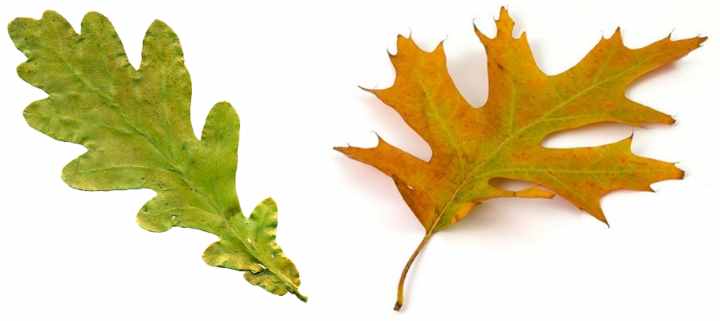
White oak leaves vs. red oak leaves: white oak leaves usually have rounded tip (left) whereas the leaves of red oak trees generally have pointed tips (right)
Generally, oak trees can be identified by their distinctive lobed leaves. White oak leaves usually have rounded tips while red oak leaves generally have pointed tips.
White oak leaves tend to have rounded lobes and rounded tips without bristles at the lobe tip. You may also see rounded serrations along the leaf edges.
Red oak trees tend to have pointed lobed leaves with bristles at their lobe tips. There is generally a greater variety of leaf shape in species of red oak trees: some leaves have tooth-like edges whereas others have smooth edges.
Oak Tree Acorns
White oak acorns mature faster than red oak acorns. The acorns of white oaks take one season to mature while the fruit of red oaks take about two seasons to mature.
Red oak acorns are larger and heavier than white oak acorns.
White oak acorns have a sweet or slightly bitter taste. Acorns from red oak trees have a very bitter, unpalatable taste.
Oak Tree Identification
To identify oak trees, look for bark that has deep fissures and ridges, giving it a scaly look. The bark color of oaks ranges from whitish-gray to dark, almost black. You can identify oak trees by their deeply lobed leaves with pointed or rounded tips.
Types of Oak Trees (with Pictures) – Identification Guide
Let’s look in detail at how to identify common types of oak trees: white oaks and red oaks.
Pin Oak Tree (Quercus palustris)
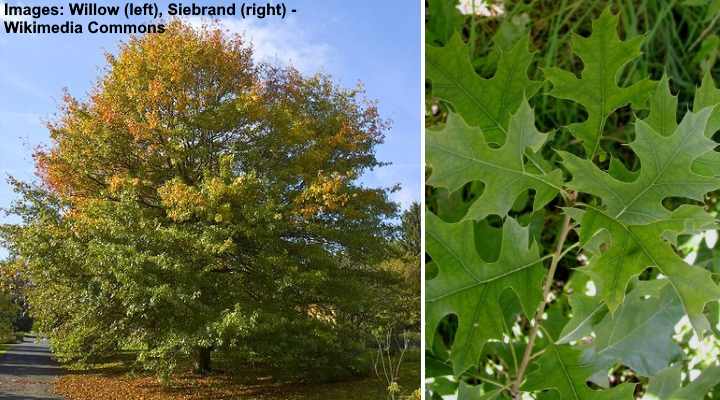
Pin oak tree and its leaves
Pin oak trees grow to medium size with a maximum height of 72 ft. (22 m). The branch growth means the trunk is barely noticeable due to lower branches drooping down. The upper canopy of the pin oak is an identifying feature with its loose, spreading growth.
Oak tree bark: Immature Pin oak trees have smooth red-gray bark that gradually becomes rougher and grayer as the tree matures.
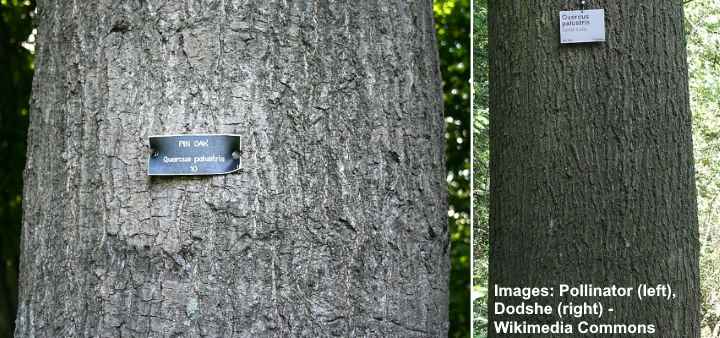
Pin oak tree bark
Oak tree leaves: The pin oak has leaves that are deeply lobed with pointed tips, creating a distinctive shape. These leaves typically have 5 to 7 lobes with 1 to 3 bristle-tipped teeth and deep sinuses nearly to the midvein. The leaves showcase a glossy green color during the summer, transitioning to a rich red or russet hue in the autumn.
Water Oak Tree (Quercus nigra)
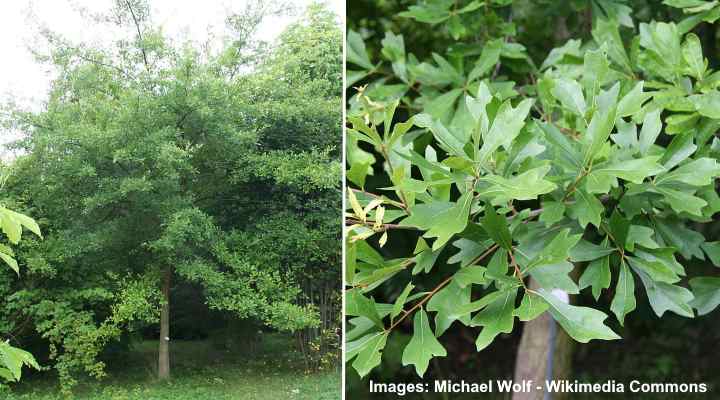
Water oak tree and leaves
Water oak trees grow up to 100 ft. (30 m) tall with leaves that don’t drop until mid-winter. The unique leaves on the water oak make it easy to identify—the dull green leaves are spoon-shaped with a slightly rounded tip and grow in clusters.
Oak tree bark: Water oak has smooth bark that becomes rough and scaly and almost black as the oak matures.

Water oak tree bark
Oak tree leaves: Water oak leaves have variation in shape—ranging from rounded like an oblong spoon to three-lobed with bristle tips.
Black Oak Tree (Quercus velutina)
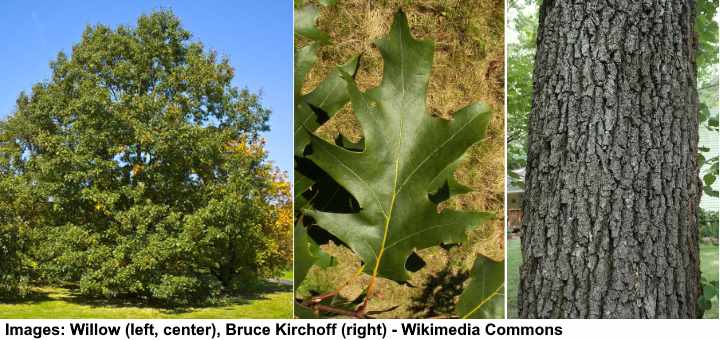
Black oak tree bark and leaves
Black oak trees grow up to 100 ft. (30 m) tall with dense foliage that grows into a sizeable flat-topped crown. Identify black oaks by their glossy green, deeply lobed leaves with U-shaped notches. This species of red oak has an orangey inner bark and dark gray outer bark.
Oak tree bark: Long shallow fissures and scaly grayish-black bark help identify the black oak.
Oak tree leaves: Black oak identification is by the shiny, deep-green leaves with U-shape notches and pointed lobes. Look for fine hairs on the underside of leaves.
Cherrybark Oak (Quercus pagoda)
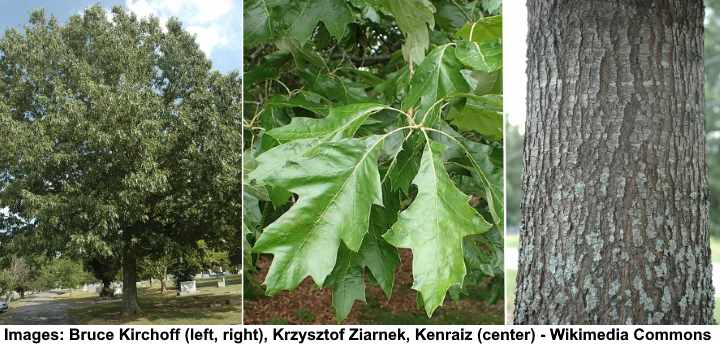
Cherrybark oak tree bark and leaves
Cherrybark oaks are one of the most towering oak trees that grow to between 100 and 130 ft. (30 – 40 m). This variety of oak is also one of the fastest-growing oak trees. The name of the oak species comes from the bark, which is similar to the black cherry tree’s bark.
Oak tree bark: Cherrybark oaks have dark gray, scaly bark that is identified by narrow ridges.
Oak tree leaves: The identifying feature of cherrybark oak leaves are the haphazard arrangement of the lobes on either side of the blade. Leaves are shiny, dark green and smooth with fine hairs on the underside.
Northern Red Oak (Quercus rubra)

Northern Red Oak leaves
The northern red oak—also called champion oak—is a tall, upright oak tree growing up to 92 ft. (28 m), and sometimes taller. The red oak tree’s foliage is lobed but sometimes less deeply than many other red oaks. This species of oak tree is one of the most popular oak trees in North America.
Oak tree bark: The unique identifying feature of the red oak bark is the shiny stripes in the center of fissures running up the tree. Bark color is dark brown to reddish-gray.
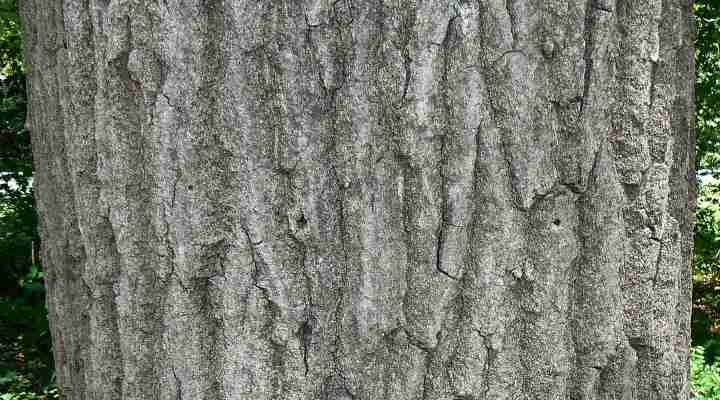
Northern Red Oak tree bark
Oak tree leaves: Northern red oak leaves are dark green, smooth and lobed with teeth on the tips of lobes.
Scarlet Oak (Quercus coccinea)
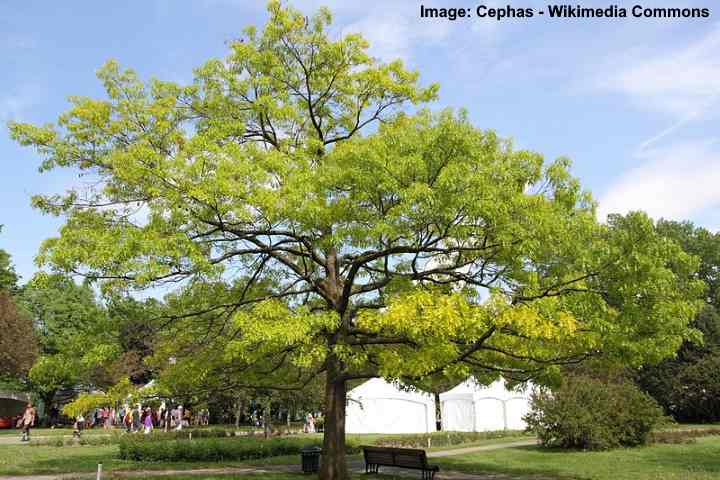
Scarlet Oak tree
The scarlet oak tree is a medium-sized oak that grows to between 67 and 100 ft. (20 – 30m). The oak tree looks similar to the pin oak or black oak. However, the difference in leaf shape helps identify between the species. Scarlet oaks have lobed leaves with C-shaped notches, not U-shaped ones.
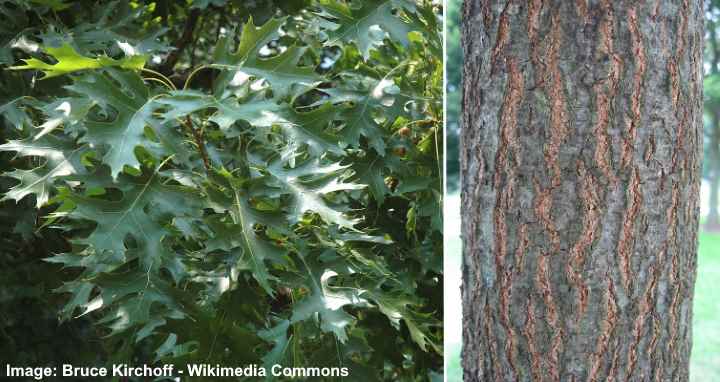
Scarlet oak tree leaves and Scarlet oak tree bark
Oak tree bark: The scarlet oak bark has irregular broad scaly ridges and fine fissures.
Oak tree leaves: Identify scarlet oak leaves by their deep lobes and C-shaped sinuses (notches between the lobes) with bristle teeth tips.
Southern Red Oak (Quercus falcata)
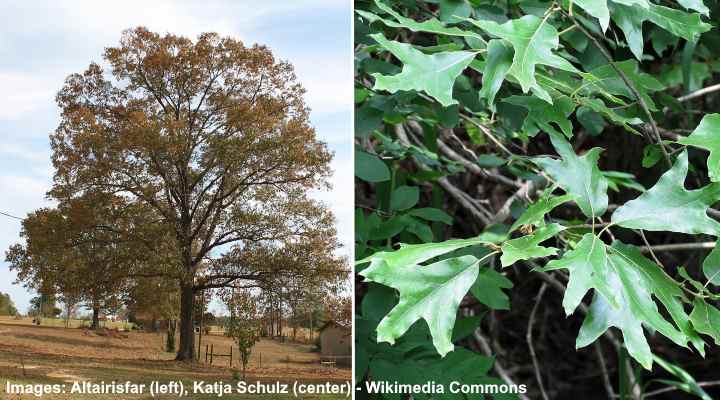
Southern Red oak and its leaves
The southern red oak—also called the Spanish oak—thrives in southern states in sandy soil and full sun. The deciduous tree grows to between 82 and 100 ft. (25 – 30 m). An identifying feature of the southern red oak is the acorns, which are orangey-brown and are shorter than other oak trees.

Southern red oak acorns
Oak tree bark: Southern red oaks have dark gray bark that is ridged with scaly plates.

Southern red oak tree bark
Oak tree leaves: Identify the southern red oak with its narrow leaves that are deeply lobed with significant gaps between the lobes.
Japanese Evergreen Oak Tree (Quercus acuta)
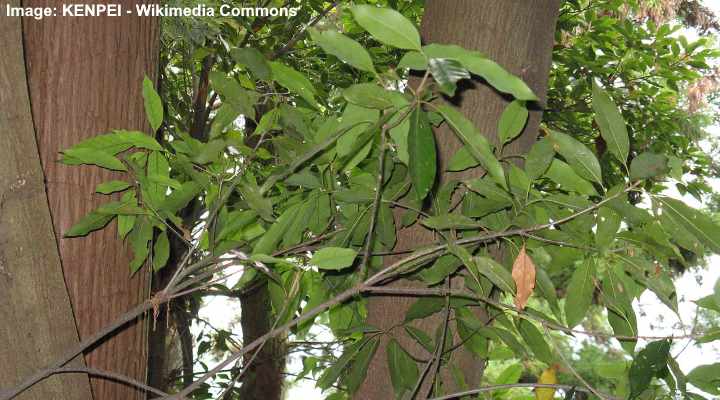
Japanese evergreen oak tree bark and leaves
The unique identifying features of the Japanese oak is that it’s the smallest oak tree and a type of evergreen tree. This evergreen oak has a maximum height of 45 ft. (14 m). Also, the smooth, narrowly lanceolate or ovate leaves and smooth bark make the Japanese oak unlike any other species of oak tree.
Oak tree bark: Japanese oaks have dark gray smooth bark, unlike most other species of oak.
Oak tree leaves: Glossy, ovate leaves that have a finely rounded tip and long point help identify the Japanese evergreen oak tree.
Laurel Oak (Quercus laurifolia)
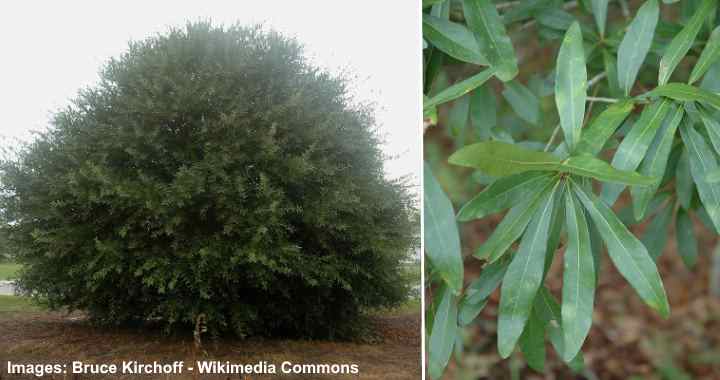
Laurel oak tree leaves
The laurel oak tree is a semi-evergreen species of oak that grows to between 65 and 70 ft. (20 -24 m). This oak tree is native to the east coast of the U.S., where it thrives in soggy soil—hence its other names of water oak and swamp laurel oak.
Oak tree bark: Laurel oak bark is dark-brown with shallow fissures and rough ridges.
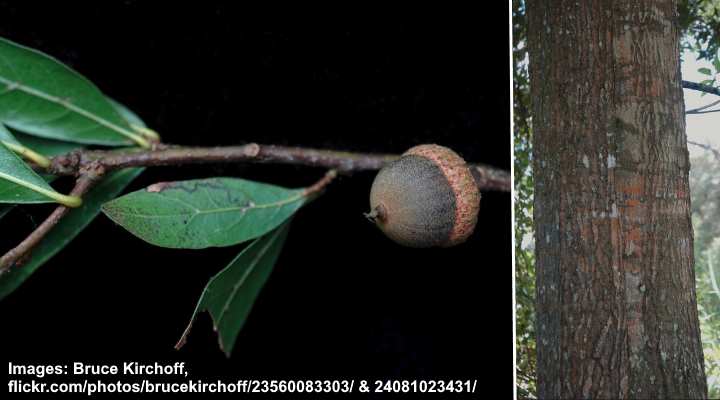
Laurel oak bark and acorn
Oak tree leaves: laurel oak has diamond-shaped shiny green leaves. Occasionally, the long narrow leaves can be lobed. The oak is also called diamond-leaf oak.
Willow Oak Tree (Quercus phellos)
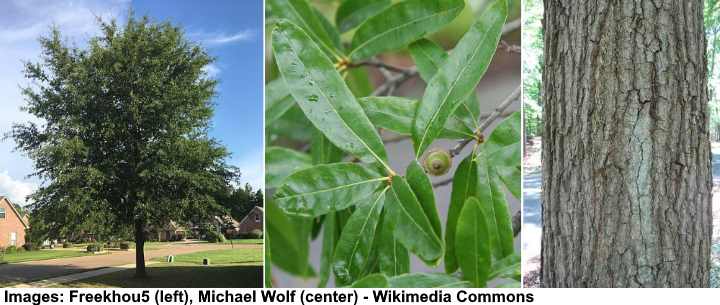
Willow oak tree bark and leaves
The willow oak tree is a medium-sized type of red oak tree that grows between 65 and 100 ft. (20 – 30 m) tall. Willow oaks are fast-growing trees that can grow 2 ft. (0.6 m) per year and have a dense oblong crown when mature.
Oak tree bark: Identify willow oak trees by their rough gray-brown bark that develops into narrow fissures as it matures.
Oak tree leaves: The willow oak has leaves that are smooth, narrow, lanceolate shaped, and pointed. The leaves of the willow oak help distinguish it from other species of red oak trees. Unlike other oak trees, willow oak leaves have no lobes or teeth.
Coast Live Oak or California Live Oak Tree (Quercus agrifolia)
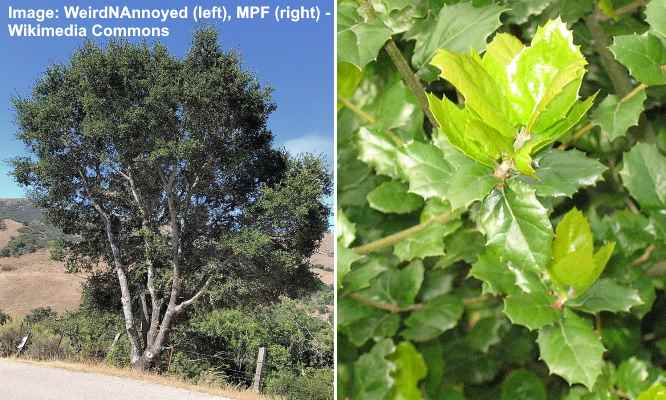
Coast live oak (Quercus agrifolia) tree and leaves
The coast live oak tree is a medium-sized, sprawling evergreen tree with smooth dark gray bark when the tree is young and becomes deeply furrowed as the tree matures, dark green spiny leaves, and narrow, egg-shaped acorns. In a landscape, the California live oak is recognized by its gnarled branching and broadly rounded crown. Coast live oak trees grow 30 to 80 ft. (10 – 25 m) tall.
Coast live oak acorns are identified by their slender egg shape with a pointed apex. The nuts are dark reddish-brown to black, and a warty cupule covers one-third of the acorn fruit. Unlike other live oak species, the acorns are ready for harvesting in seven months.
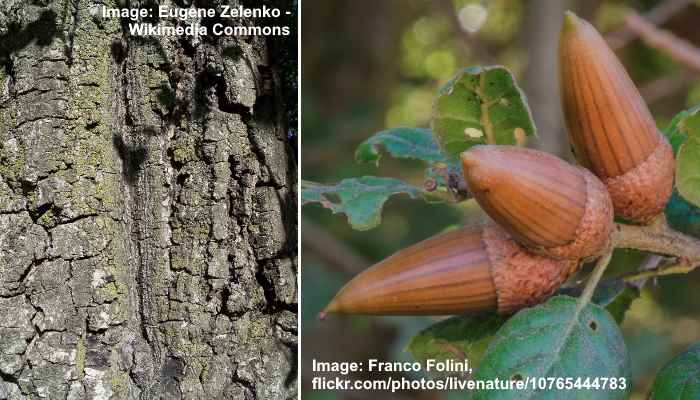
Bark of a mature coast live oak tree and acorns
Looking at pictures of coast live oak tree leaves, you’ll notice that they resemble holly leaves. The glossy green evergreen leaves are an oval shape with spiny margins. The oak tree leaves drop in early spring, and new leaves quickly follow. Leaves measure 2” to 7” (0.8 – 2.7 cm) long and up to 1.5” (4 cm) wide.
When in bloom, the coast live oak produces dangling yellow-green or yellowish-red clusters of flowers on 2” to 4” (5 – 10 cm) stems.
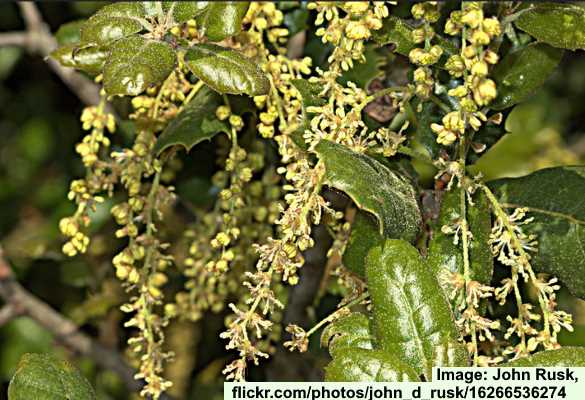
Coast live oak tree flowers
In a landscape, coast live oak trees are majestic specimen trees for USDA zones 9 through 11. You can also plant the tree and shear it to grow an evergreen hedge.
Oak tree bark: Coast live oak tree bark is smooth and gray and becomes deeply furrowed as the tree matures.
Oak tree leaves: Coast live oak tree leaves are identified by their oval shape, leathery feel, and sharp spines around the margins.
Interior Live Oak (Quercus wislizenii)
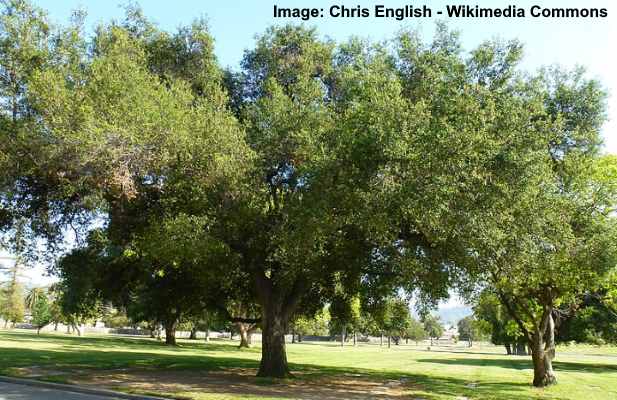
Interior live oak (Quercus wislizenii)
The interior live oak is an evergreen oak tree native to the southwestern United States. It is a slow-growing, drought-tolerant tree that can reach up to 72 ft. (25 m) tall and has a broad, spreading crown. The interior live oak is known for its long, narrow and pointed acorns.
The interior live oak is native to California’s coastal range to the Sierra foothills.
Oak tree bark: The interior live oak has grayish bark that becomes furrowed and forms checkered scales.
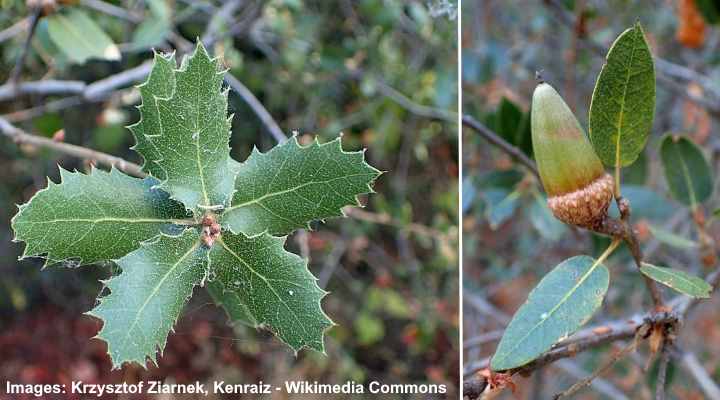
Interior live oak leaves can have spiny margins on young trees at higher elevations or smooth margins
Oak tree leaves: The interior live oak has thick, leathery leaves that are dark green on top and pale underneath. They are oval or elliptical and have smooth or toothed edges like holly leaves. The leaves remain green throughout the year.
Shumard Oak Tree (Quercus shumardii)
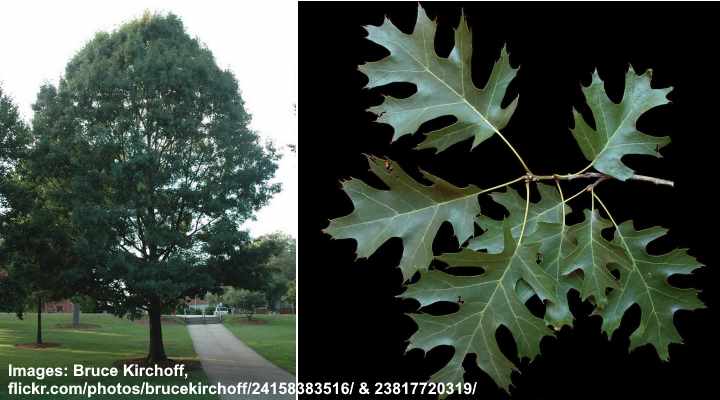
Shumard oak (Quercus shumardii) tree and leaves
The Shumard oak tree is an impressive deciduous oak tree in the red oak family and has a recognizable pyramidal crown. This fast-growing oak tree has dark green leaves with deeply-cut lobes. The acorns have a rounded shape and flat base. Shumard oak bark is smooth and gray that becomes rough and dark gray.

Shumard oak tree bark and acorn
Shumard oak trees grow 50 to 70 ft. (15 – 21 m) tall and spread 30 to 40 ft. (9 – 12 m). The oak tree grows best in open landscapes in USDA zones 5 through 9. Like all oaks, the tree thrives in full sun and moist soil with good drainage.
One of the attractive features of the Shumard oak tree is the jaggy-looking, deeply lobed leaves. The leaves measure 4” to 8” (10 – 20 cm) long and have five to nine pointed lobes with soft, bristle-like tips. In the fall, Shumard oak foliage turns an eye-catching red color.
Shumard oak trees produce oval acorns that measure up to 1.25” (3 cm) long. The brown acorns are identified by their rounded apex and flattened base, giving them a stocky appearance. The acorn’s cap is thin and scaly and typically covers less than one-third of the acorn.
Oak tree bark: Shumard oak tree bark is smooth and gray on immature trees and gradually becomes rough, furrowed, and dark gray in time.
Oak tree leaves: Shumard oak tree leaves have recognizable deep, pointed lobes with bristly tips. The leaves typically have 5 to 9 lobes with 2 to 5 bristle-tipped teeth and deep sinuses extending more than halfway to the midvein. The broadly obovate leaves are dark green on the upper side and pale green on the underside. The oak leaves turn a spectacular bright red color in the fall.
Turkey Oak Tree (Quercus laevis)

Turkey oak (Quercus laevis) tree and leaves
The turkey oak is a small acorn tree with deeply lobed green leaves, small reddish-brown acorns, and dark gray to black bark. These oak trees only grow 26 to 33 ft. (8 – 10 m) tall and thrive in poor soil where other oaks can’t grow. The oak tree has medium growth and matures to form a rounded, spreading crown.
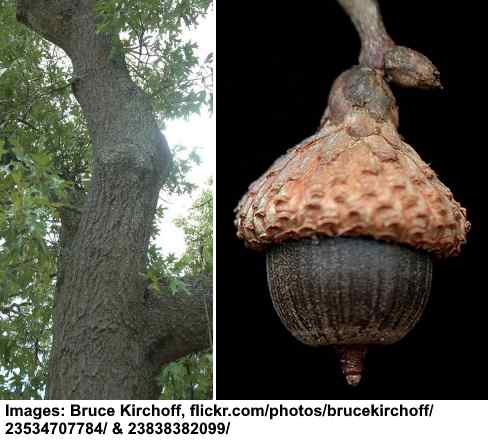
Turkey oak tree bark and acorn
Oak tree bark: Turkey oak tree bark is identified by its dark gray color and irregular ridged patterning.
Oak tree leaves: Turkey oak tree leaves are dark green with distinctive slender lobes and deep sinuses, giving the leaf a resemblance to a turkey foot. The oak tree’s fall color is reddish-brown, and the leaves persist until winter.
California Black Oak (Quercus kelloggii)
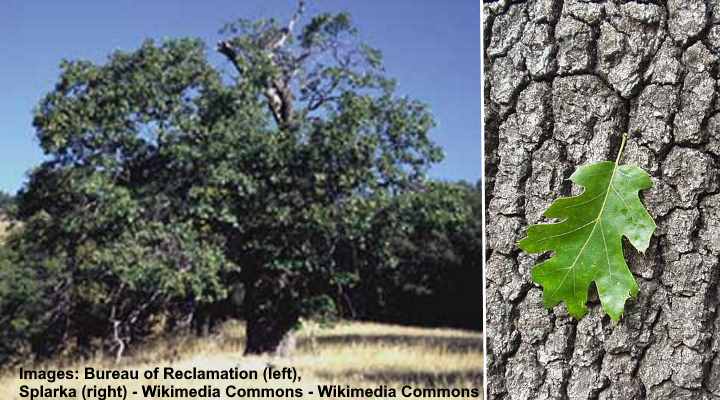
California black oak (Quercus kelloggii) tree, bark and leaf
The California black oak is a large deciduous oak tree belonging to the red oak section. It thrives throughout the state, from the Pacific Ocean in the west to the Nevada desert in the east.
The attractive oak tree has a broad, rounded crown and grows 30 to 80 ft. (9 – 24 m) tall, with a trunk diameter of up to 4 ft. (1.2 m). It has large egg-shaped acorns measuring 1” to 1.5” (2.5 – 4 cm) long. The California black oak
The California black oak, is primarily native to the western United States, particularly prevalent in the Sierra Nevada and Coast Ranges of California, as well as in southwestern Oregon and northern Baja California.
Oak tree bark: California black oak bark is dark gray to black and ridged with blocky patterns on the trunk.
Oak tree leaves: California black oak leaves measure 4” – 9.75” (10 – 25 cm) long. The leaves feature seven deep lobes and emerge red, turn green in summer, and then orange-brown in the fall.
Channel Island Oak (Quercus tomentella)
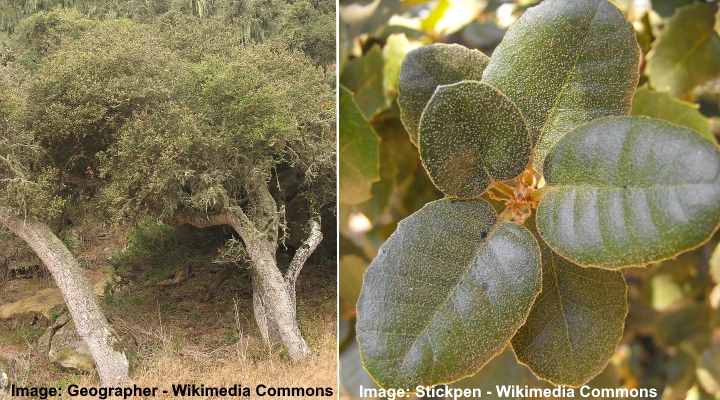
Channel Island oak (Quercus tomentella) tree and leaves
Channel island oak trees are species of red oak and are found on the six islands off California’s coastline. The island oak tree has a rounded crown and grows 66 ft. (20 m) tall. The heat-loving oak is characterized by its reddish-brown trunk, leathery leaves, and acorns with rounded tips. The island tree’s acorns grow 1.37” (3.5 cm) long and 1.1” (3 cm) wide.
Oak tree bark: Channel Island oak tree bark is recognized by its grayish to reddish-brown furrowed bark with a scaly texture.
Oak tree leaves: Channel Island oak evergreen leaves have pointed or rounded tips, and the edges can be smooth or toothed. The leaves measure 2.75” to 4” (7 – 10 cm) long.
Santa Cruz Island Oak (Quercus parvula)
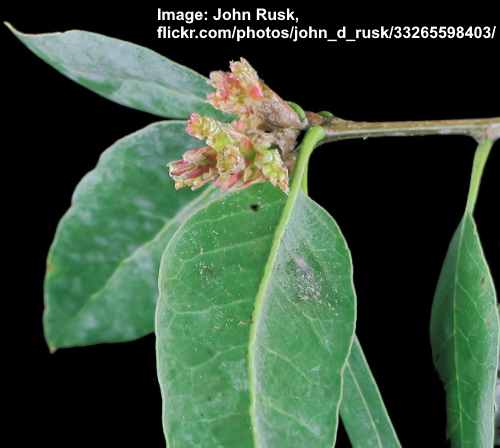
Santa Cruz Island oak (Quercus parvula var. parvula) leaves
The Santa Cruz Island oak is a type of red oak tree native to the California Coastal Ranges and Santa Barbara. The tree has a small, twisted trunk and branches that form a dense, vase-shaped, upward-spreading crown. Santa Cruz Island oaks grow 56 to 72 ft. (17 – 22 m) tall, and produce large, elongated oval acorns in large, brown warty cups.
The Shreve oak (Quercus parvula var. shrevei) is related to the Santa Cruz Island oak and looks similar.
Oak tree bark: Santa Cruz Island oak tree bark is gray to brown with irregular shallow furrows and ridges, creating a rough texture.
Oak tree leaves: Santa Cruz Island oak tree leaves are small, leathery lance-shaped blades with greenish-yellow veining and a pointed apex. They measure 1.6” (4 cm) long.
Types of White Oak Trees (with Pictures) – Identification Guide
Eastern White Oak (Quercus alba)
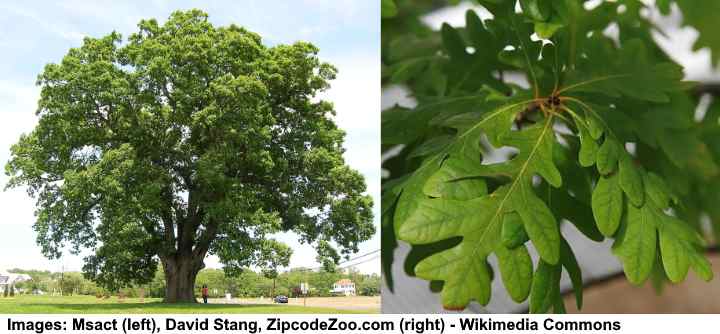
Eastern White oak tree and its leaves
The eastern white oak is a massive tree that grows around 100 ft. (30 m) with a large wide, spreading canopy. The white oak is prized for its white hardwood.
Oak tree bark: The eastern oak has light grayish-white bark with thin, narrow fissures. To identify the oak tree by its bark, look for overlapping scales about halfway up the trunk.
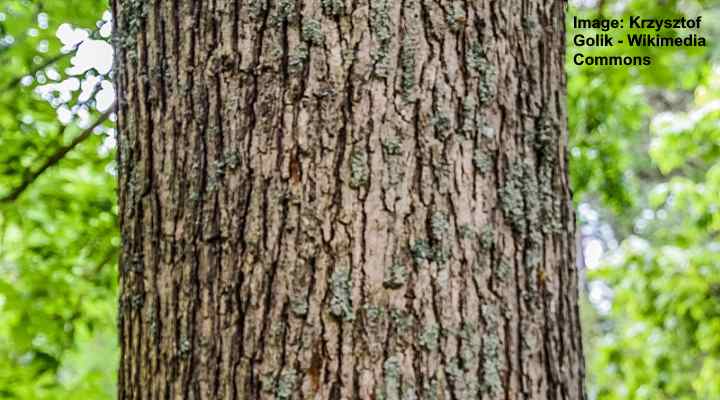
Eastern white oak tree (Quercus alba) bark
Oak tree leaves: Large obovate leaves that have deep lobes with rounded tips.
English Oak (Quercus robur)
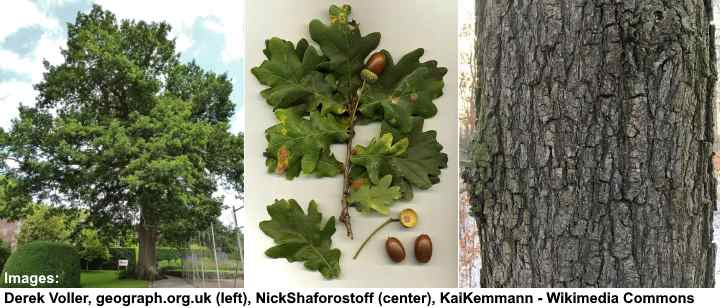
English oak bark, leaves, and acorns
The English oak—or common oak—is a majestic oak tree growing to a height of between 40 and 70 ft. (12 – 21 m). The English oak is identified by its sizeable spreading crown and thick, hard trunk that can be between 13 and 40 ft. (4 – 12 m) in diameter.
Oak tree bark: English oak has blackish-gray bark with deep fissuring covering the thick trunk and thick branches.
Oak tree leaves: You can easily identify English oak leaves by their small, rounded lobed leaves with smooth leaf edges. English oak leaves have the classic shape of these acorn-producing trees
Post Oak (Quercus stellata)
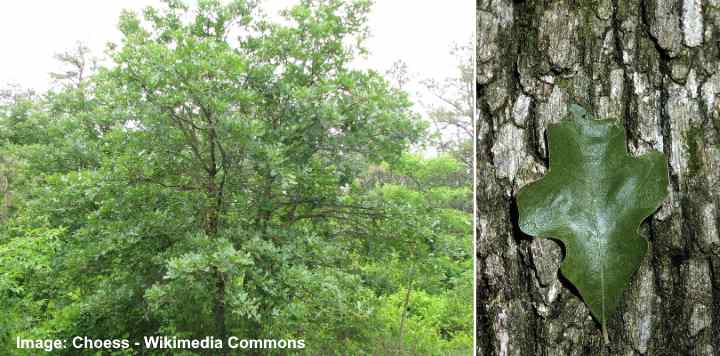
Post oak tree bark, leaves and general shape
The post oak is a type of white oak tree that is one of the smaller species in the genus Quercus. Post oaks grow to between 33 and 50 ft. (10 – 15 m) and have a thick trunk. To identify the post oak, look for its short stature and huge spreading crown.
Oak tree bark: Thick fissured bark that is a light gray color identifies the post oak tree.
Oak tree leaves: The post oak is identified by its slightly lobed leaves that form the shape of a cross—some say, similar to the Maltese cross.
Bur Oak (Quercus macrocarpa)
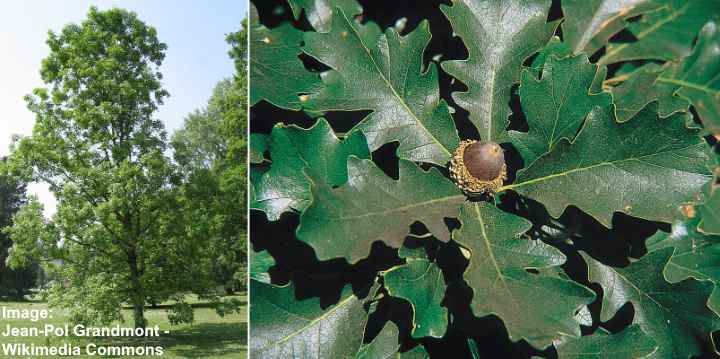
Bur oak tree leaves and acorn
The bur oak tree is a large species of white oak tree that grows up to around 100 ft. (30 m) high and sometimes as tall as 160 ft. (50 m). The bur oak is one of the enormous oaks in terms of density, with trunks as large as 10 ft. (3 m) in diameter. This slow-growing oak tree grows throughout North America.
Oak tree bark: Bur oak tree has medium-gray bark with deep, narrow scales and vertical ridges.
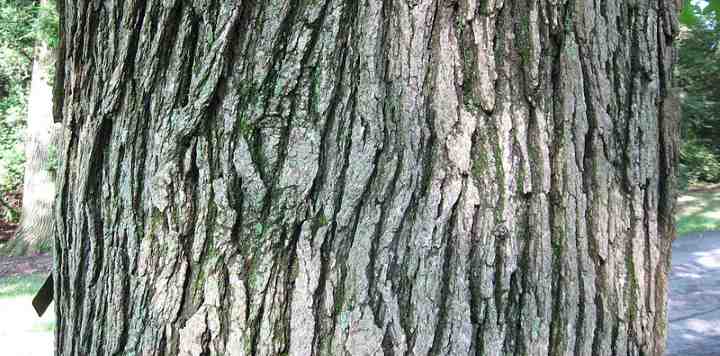
Bur oak tree bark
Oak tree leaves: Bur oaks have unusually-shaped large leaves with small lobes up to half the leaf’s length and a broad rounded apex.
Sand post oak (Quercus margarettae)
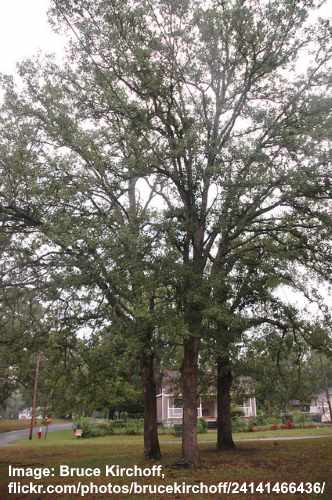
Sand post oak (Quercus margarettae)
The sand post oak is one of the smallest white oaks and only grows up to 40 ft. (12 m) tall. The shrub-like oak tree thrives in southeastern states in sandy soil.
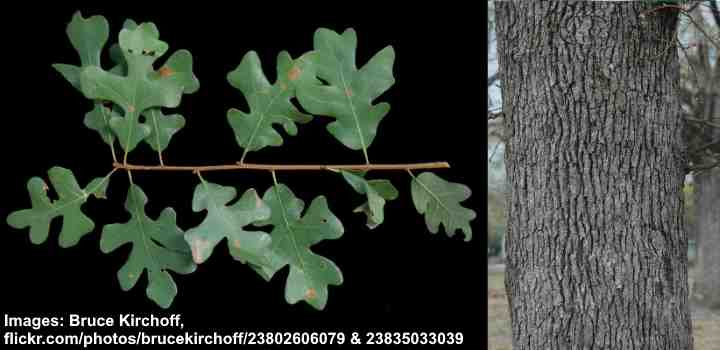
Sand post oak leaves and bark
Oak tree bark: Sand post oak trees have gray bark with shallow fissure and scaly ridges.
Oak tree leaves: Identify sand post oaks with their deeply lobed, rounded leaves that have rounded tip.
Oregon White Oak (Quercus garryana)
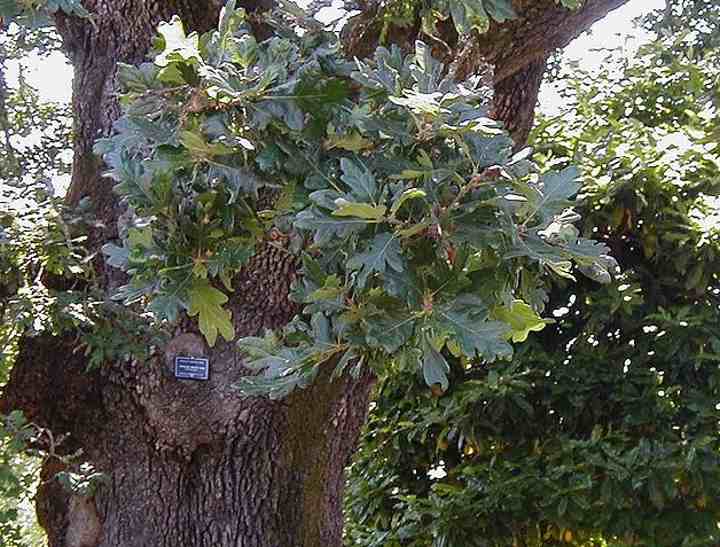
Oregon White oak bark and leaves
The Oregon white oak is native to the northwest coast of North America and grows between 65 and 100 ft. (20 – 30 m). Some types or Oregon oaks can grow as shrubs in small garden landscapes where they grow to between 10 and 16 ft. (3 to 5 m) tall.
Oak tree bark: Oregon white oak tree has bark that is lightly gray, heavily furrowed with pronounced ridges.
Oak tree leaves: Oregon white oak tree has glossy green lobed leaves with rounded tips. The leaves have “U” shaped sinuses and a slightly rounded apex.
Sessile Oak (Quercus petraea)
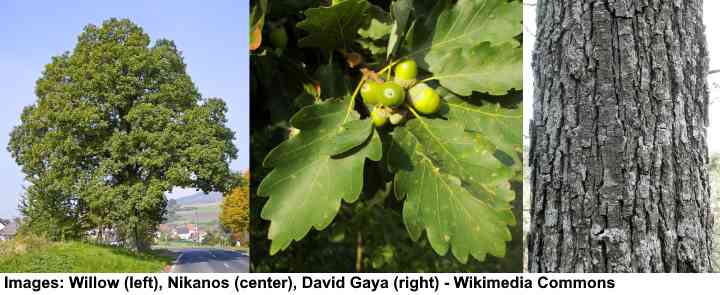
Sessile Oak bark, leaves and acorns
The sessile oak is a large species of white oak that grows to between 66 and 130 ft. (20 – 40 m) tall. Native to Europe, the sessile oak is widespread in Ireland and is also called the Irish oak. The deciduous oak’s leaves turn from dark olive green to golden yellow in the fall.
Oak tree bark: The sessile oak tree has smooth gray bark when young that gradually becomes fissured as it matures.
Oak tree leaves: Identify the sessile oak tree by its sinuated leaves that are slightly lobed and look like teeth around the margins.
Chestnut Oak (Quercus montana)
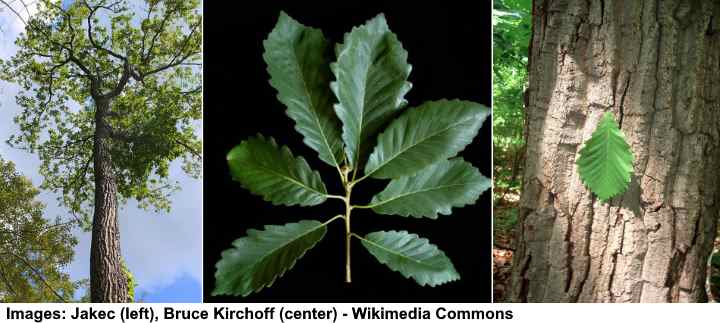
Chestnut oak (Quercus montana) bark and leaves
Chestnut oak trees are medium-sized white oak trees that grow to between 60 and 70 ft. (18 – 22 m) tall. Most of the foliage and branches grow at the top of the chestnut oak, where it has a spreading crown of up to 70 ft. (18 m) wide.
Chestnut oak is native to the eastern United States, primarily found in regions such as the Appalachian Mountains and the Piedmont of the Southeastern United States.
Oak tree bark: The chestnut oak is identified by its unique bark that has deep fissures producing pronounced peaked ridges.
Oak tree leaves: Chestnut oak leaves grow in clusters with bristle tooth edges and no lobbing. Pronounced veins in V-shapes also help identify the chestnut oak leaves.
Holm Oak (Quercus ilex)
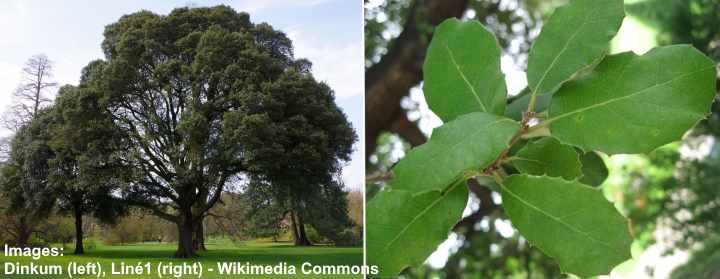
Holm oak tree and its leaves
Holm oak tree is an evergreen species of white oak tree that also has names such as evergreen oak and holly oak. Holm oaks are a medium to large-sized variety of oak tree that grows to 70 to 91 ft. (21 – 28 m).
Oak tree bark: Unlike other types of oak tree, the Holm oak has gray to black bark with fine fissures that look more like small cracks on the tree, similar to parched ground.
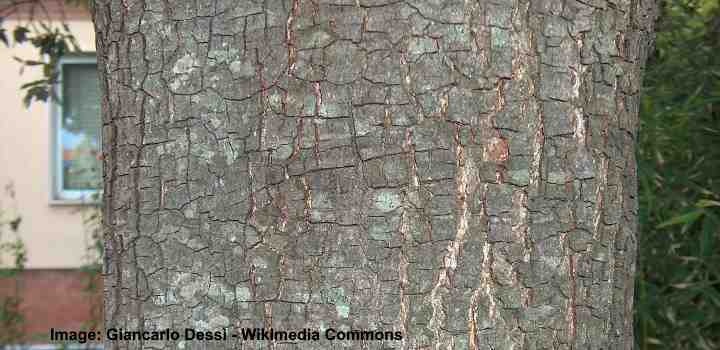
Holm oak tree bark
Oak tree leaves: The holm oak is identified by its glossy leaves that are oblong to lanceolate shaped without any lobes.
Chinkapin Oak Tree (Quercus muehlenbergii)
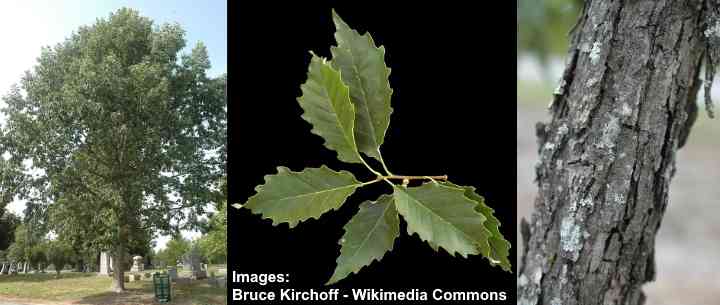
Chinkapin oak tree bark and leaves
The chinkapin oak is a large white oak tree that grows to between 45 and 110 ft. (20 – 33 m). This oak tree has branches that emerge from the trunk reasonably close to the ground. The leaf growth is similar to the chestnut oak tree; however, the chinkapin oak has pointed, not rounded teeth, on its blade margins.
From all of the white oak tree species, the chinkapin tree has the sweetest acorns.
Oak tree bark: Identify the chinkapin oak tree by its flaky gray bark and shallow fissures.
Oak tree leaves: Chinkapin oak tree has leaves that look like chestnut leaves, only with sharper, pointed teeth without any bristles.
Live Oak Tree (Quercus Virginiana)
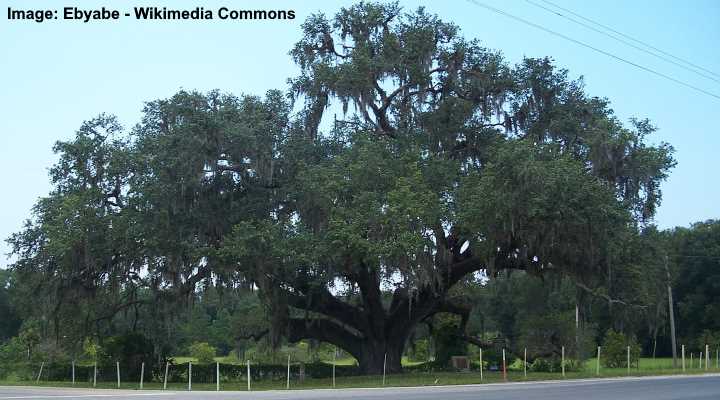
Live oak tree (Quercus virginiana)
The live oak tree is a sprawling evergreen tree identified by its broad crown, glossy dark-green leathery leaves, and dark brown oval acorns. The evergreen oak tree has thick dark brown bark with deep furrows running up the trunk. Live oaks grow 40 to 80 ft. (12 – 24 m) tall and up to 100 ft. (30 m) wide.
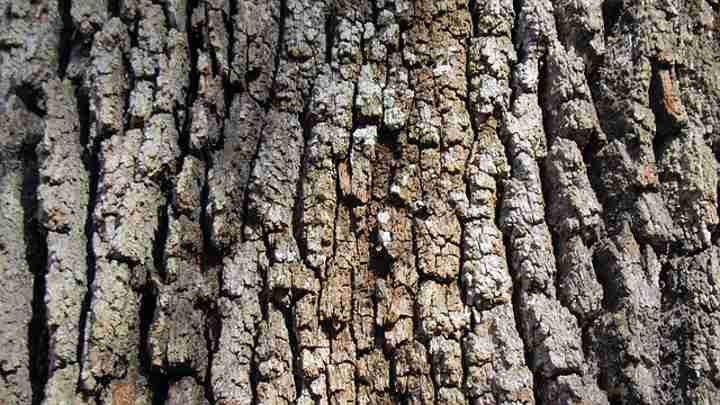
Bark of a mature Southern live oak tree
Unlike traditional deciduous oak trees, the live oak has thick leaves with a fuzzy underside. The leaves are an oblong, oval shape without the characteristic lobed margins of English oaks. The evergreen leaves are 2” to 5” (5 – 13 cm) long and up to 1.5” (4 cm) wide.
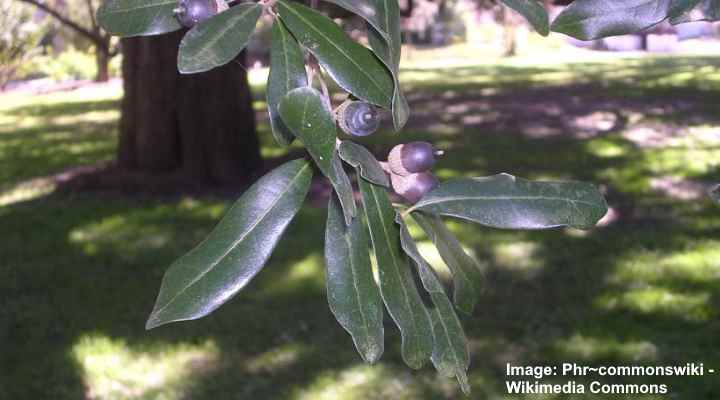
Live oak tree leaves and acorns
In the spring, a live oak tree blooms with yellowish-green flower clusters (catkins). These inconspicuous cylindrical flowers grow around 3” (7.5 cm) long and flower in small groups.
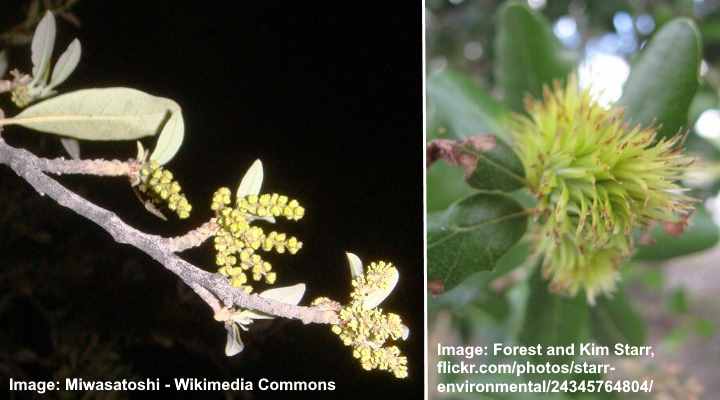
Live oak tree male flowers (left) and female flowers (right)
After blooming, the female flowers develop into dark brown egg-shaped acorns with a warty cap. You can recognize live tree acorns by their dark color and caps covering one-third of the nuts. These oak tree nuts grow in clusters of five and are ready for harvesting from September through November.
Live oak trees thrive in USDA zones 8 to 10. The hardwood oak trees perform best in full sun and moist, well-drained soil.
Oak tree bark: Live oak tree bark is identified by its dark brown scaly bark with reddish furrows visible on immature trees.
Oak tree leaves: Live oak tree leaves are an elliptical, lanceolate shape with a glossy dark-green sheen, leathery feel, and grayish fuzzy underside.
Swamp White Oak Tree (Quercus Bicolor)
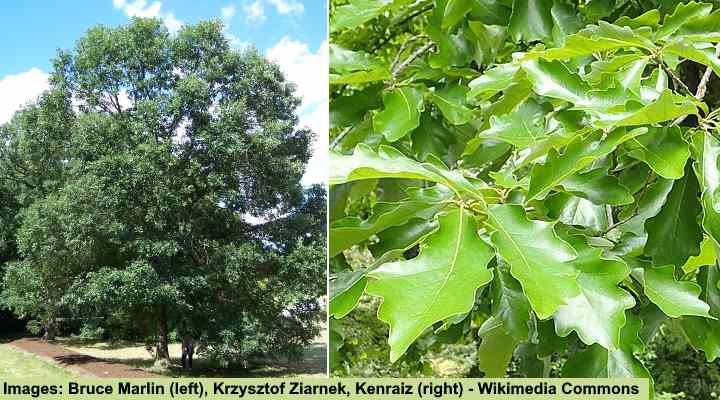
Swamp white oak (Quercus Bicolor) tree and leaves
Swamp white oak is a large deciduous tree recognized by its open rounded crown, peeling dark gray bark, ovate or obovate leaves with lobed margins, and brown barrel-shaped acorns. Swamp white oaks bloom with dangling catkins of golden yellow flowers in spring.
Swamp white oak trees grow 50 to 90 ft. (15 – 27 m) tall and up to 100 ft. (30 m) wide. The tree’s huge spread makes it an ideal shade tree in open landscapes. To grow a swamp oak tree, it must get full sun and be planted in well-drained, loamy soil.
Leaves growing on a swamp white oak tree are bright green with a broad oval shape. The deciduous leaves measure 4” to 7” (10 – 17 cm) long and up to 4” (10 cm) at the widest point. Swamp oak tree leaves turn a yellowish-brown or red color in the fall.
Swamp white oak tree acorns are stumpy oval brown nuts around 0.8” (2 cm) long and wide. The gray scaly acorn cap has fine hairs, and it covers about one-half of the acorn.
Oak tree bark: Swamp oak tree bark is light to dark-gray with a scaly appearance and deep, rough, vertical furrows. Immature swamp oak trees are identified by their smooth whitish-gray peeling bark.
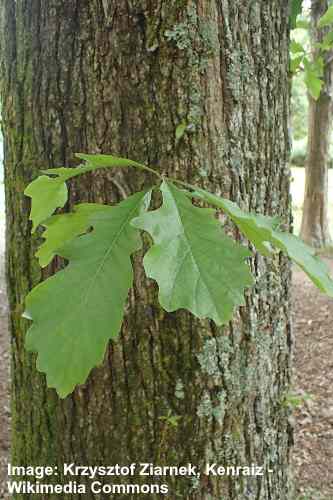
Swamp white oak tree (Quercus Bicolor) bark and leaves
Oak tree leaves: Swamp oak tree leaves are identified by their ovate shape with a tapered end at the petiole. The green leaf margins have five to seven shallow, rounded lobes.
Gambel Oak Tree (Quercus Gambelii)
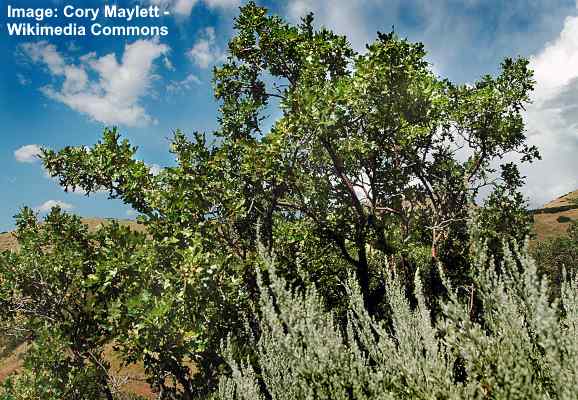
Gambel oak tree (Quercus Gambelii)
The Gambel oak tree is a small, shrub-like oak tree that grows 10 to 30 ft. (3 – 9 m) tall. The small oak tree is identified by its obovate leaves with distinct deep rounded lobes, small greenish-brown acorns, and insignificant yellow flowers. This clump-forming oak tree also has rough brownish-gray bark.
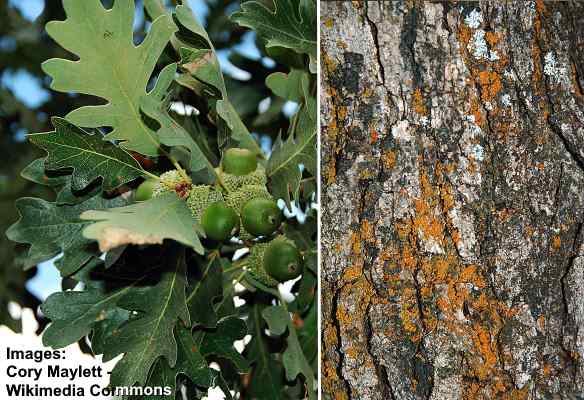
Gambel oak tree leaves, immature acorns and bark
Gambel oak tree acorns are egg-shaped nuts in yellowish-green, green, and light brown shades. The oval acorns sit in a wide green warty cap covering one-third of its length. The sweet nuts are a source of food for local wildlife.
Also called the scrub oak or oak brush, the perennial deciduous oak tree has easily-recognizable leaves in the typical oak tree leaf shape. In the fall, the foliage on the Gambel oak tree turns attractive orange, yellow, and red shades.
Gambel oak trees are suitable for planting in USDA zones 4 through 8. The drought-tolerant tree grows well in full sun. Although this suckering oak tree can be trained as a hedge, it looks best grown as a landscape tree.
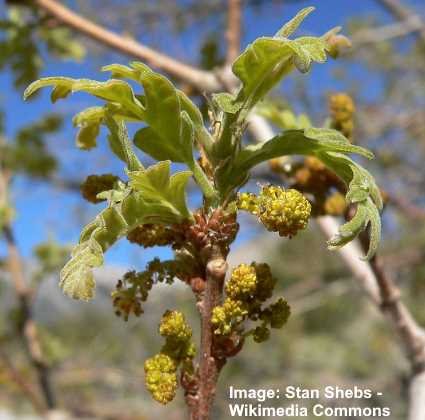
Gambel oak flowers
Oak tree bark: Gambel oak tree bark is rough and scaly with a brownish-gray appearance.
Oak tree leaves: Gambel oak tree leaves have a characteristic oval shape with deep lobes that almost reach the central vein. The oak leaves measure 3” – 4.5” (7 – 12 cm) long and 1.5” – 2.5” (4 – 6 cm) wide.
Overcup Oak Tree (Quercus lyrata)
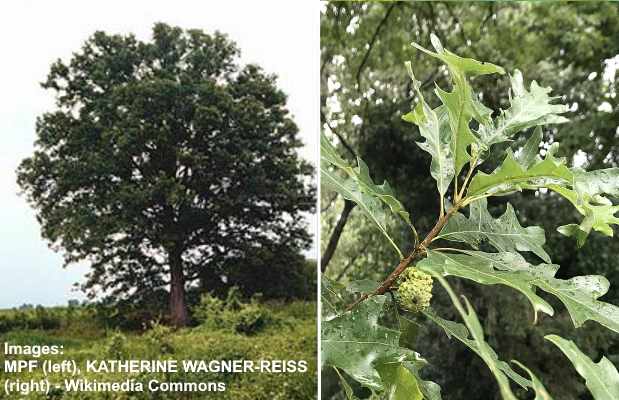
Overcup oak (Quercus lyrata) tree and leaves
The overcup oak tree is a species of white oak identified by its unusual light brown to tan acorns, deeply lobed glossy green leaves, and dark gray furrowed bark. In a landscape, an overcup oak has a recognizable domed crown. Overcup oaks grow 45 to 70 ft. (13 – 21 m) high with a 45 ft. (13 m) spread.
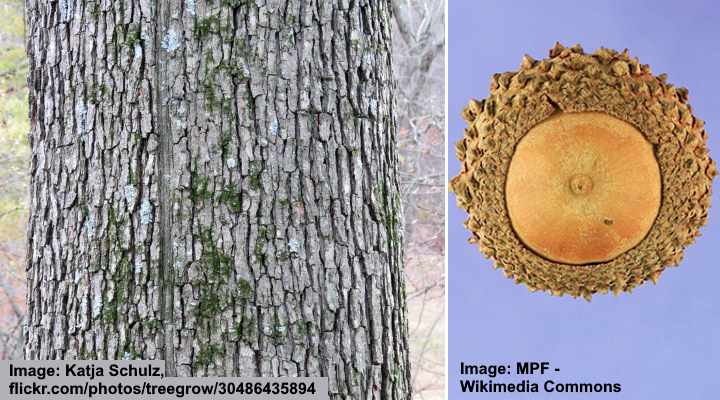
Overcup oak tree bark and acorn
Apart from its attractive uniformly rounded crown, acorns help identify the overcup oak tree. The warty acorn cap almost covers the entire nut. Each nut measures 0.5” – 1” (1.3 – 2.5 cm) long. Its bur-like cap is how the oak tree gets its common name.
Overcup oak tree leaves are a wedge shape with characteristic lobed margins — typical of deciduous oak trees. Leaves measure 6” to 8” (15 – 20 cm) long and have a glossy green upper side and fuzzy gray-green underside. The oak tree’s fall color is coppery-brown or deep red.
Oak tree bark: Overcup oak tree bark is identified as dark gray with furrowed ridges forming irregular patterns of scaly ridges up the trunk.
Oak tree leaves: Overcup oak tree leaves are glossy green with a leathery texture and distinctive wedge shape. The oak leaf margins have five to nine deeply rounded lobes, and the green leaves turn yellow, brown, or red in the fall.
Swamp Chestnut Oak Tree (Quercus michauxii)
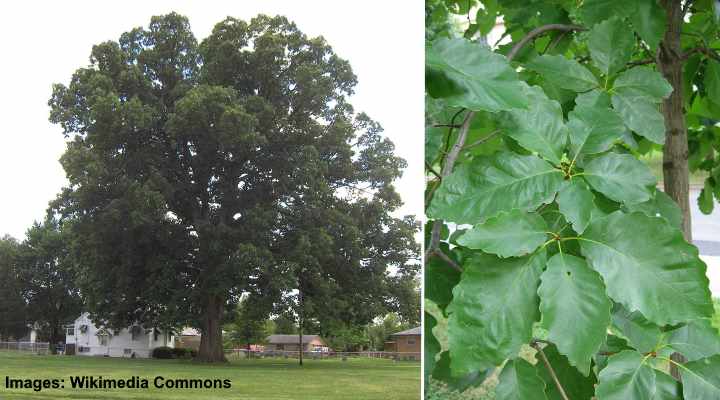
Swamp chestnut oak (Quercus michauxii) tree and leaves
The swamp chestnut oak tree is a tall deciduous tree with an open, spreading irregular crown. The tree is a species of white oak, identified by its obovate leaves with wavy margins, brown rounded edible acorns, and scaly bark with flaky gray ridges. The swamp chestnut oak grows around 65 ft. (20 m) tall.
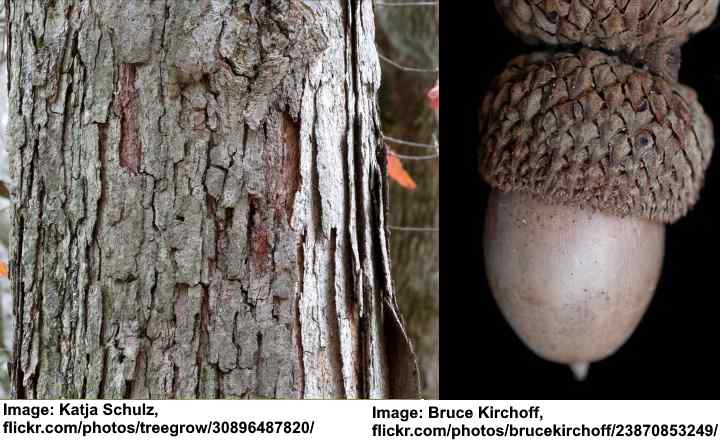
Swamp chestnut oak tree bark and acorn
The swamp chestnut oak tree has several unique features not found on other species of Quercus. For example, the large, sweet acorns can be eaten straight off the tree without having to leech the tannins.
A unique characteristic of the swamp chestnut tree is its wood that can be split into thin, flexible strips. These strips of oak wood are useful for making baskets, and this growth characteristic is why the tree is also named the basket oak.
Oak tree bark: The swamp chestnut oak tree has identifiable bark that is thin and scaly and tends to peel as the tree matures.
Oak tree leaves: The swamp chestnut tree has obovate leaves with toothed margins giving them a wavy appearance. The glossy green leaves grow 11” long (27 cm) and look like chestnut leaves. In the fall, the swamp chestnut tree turns brilliant colors of bright red.
Dwarf Chestnut Oak Tree (Quercus prinoides)
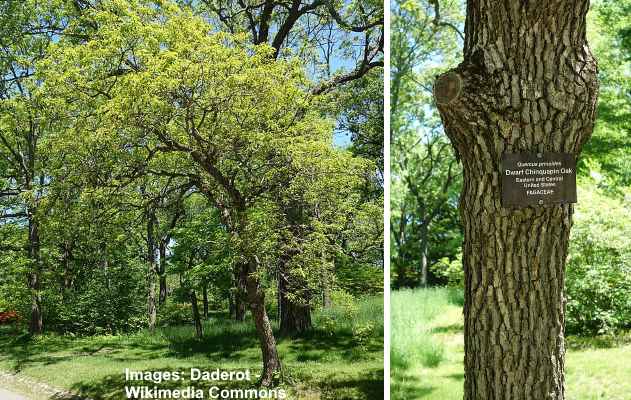
Dwarf chestnut oak (Quercus Prinoides) tree and bark
Also called the dwarf chinkapin oak, the small deciduous shrub-like oak tree grows 13 – 20 ft. (4 – 6 m) tall. The dwarf oak has oval leaves with toothed margins, brown oval acorns, and brownish-gray bark with rough, texture scaly bark.
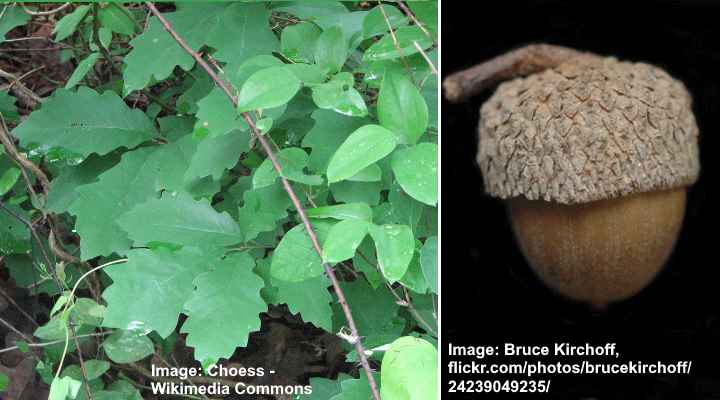
Dwarf chestnut oak leaves and acorn
Oak tree bark: The dwarf chestnut oak bark is dark brown or gray with a scaly bark and irregular fissures.
Oak tree leaves: Dwarf chestnut oak leaves are identified as ovate leaves with small lobes around the margins. The leaves measure 2” to 5” (5 – 13 cm) long and 2.5” (6 cm) wide.
Bluejack Oak Tree (Quercus incana)
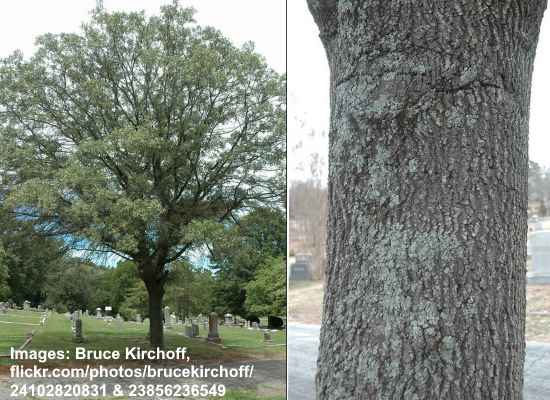
Bluejack oak (Quercus incana) tree and bark
Bluejack Oak is a medium sized tree with blue-green leaves, a short trunk with dark gray platy bark, brown acorns, and an irregular crown. The attractive glossy leaves create dense foliage, but the dwarf oak tree lacks any fall color. Bluejack oak trees typically grow 30 ft. (10 m) tall.
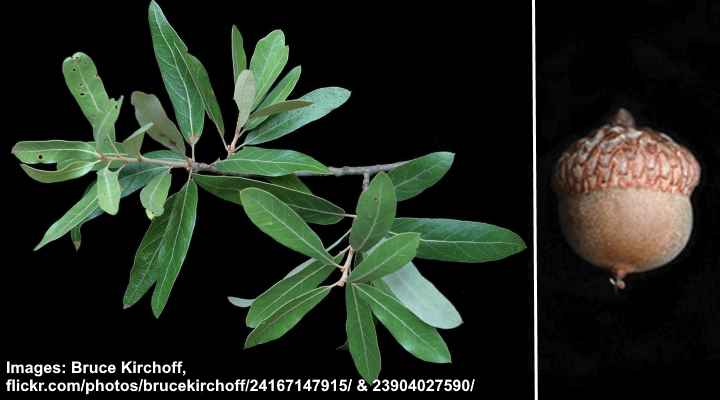
Bluejack oak leaves and acorn
Oak tree bark: Bluejack oak bark is dark gray or black with pronounced furrows and square plates.
Oak tree leaves: Bluejack oak leaves are glossy green, ovate leaves with a rounded apex and measure 4” (10 cm) long and 1” (2.5 cm) broad. The leathery leaves remain on the tree until winter.
Bluff Oak Tree (Quercus austrina)
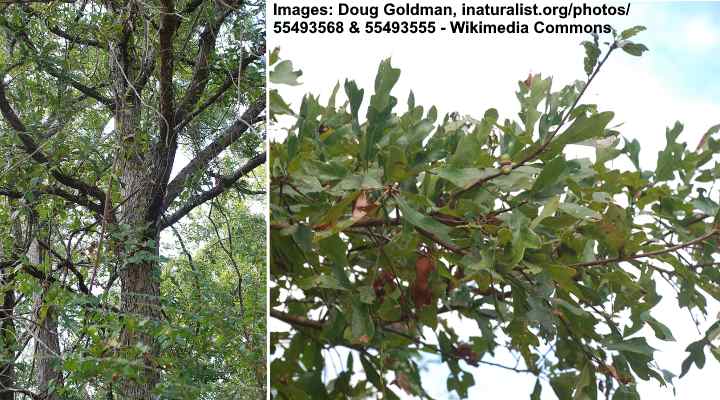
Bluff oak (Quercus austrina) tree and leaves
The bluff oak is a deciduous oak tree that is identified by its distinctive narrow leaves, small brown acorns with a gray scaly cap, and light gray-brownish bark with scaly ridges. Bluff oak trees grow between 45 and 60 ft. (14 – 18 m) high and have an open, rounded crown.
Oak tree bark: Bluff oak trees have scaly, light gray-brown bark that develops into broad ridges.
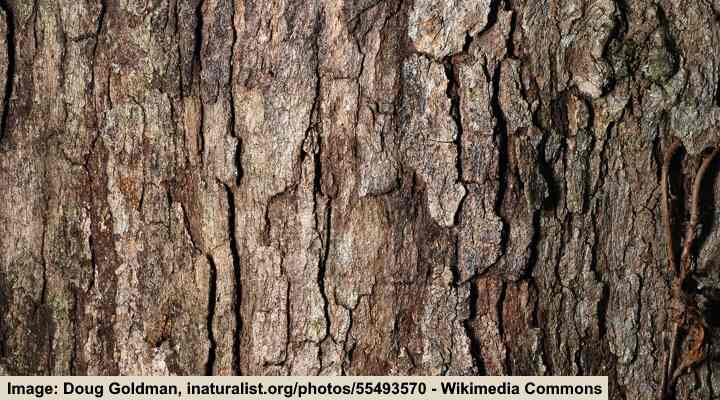
Bluff oak bark
Oak tree leaves: Bluff oak tree leaves are slender, elliptical blades with shallow lobes along the margins. The leaves measure 4” to 8” (10 – 20 cm) long and up to 4” (10 cm) wide. The oak tree’s fall color is yellow, orange, or coppery-brown.
Chapman Oak Tree (Quercus chapmanii)
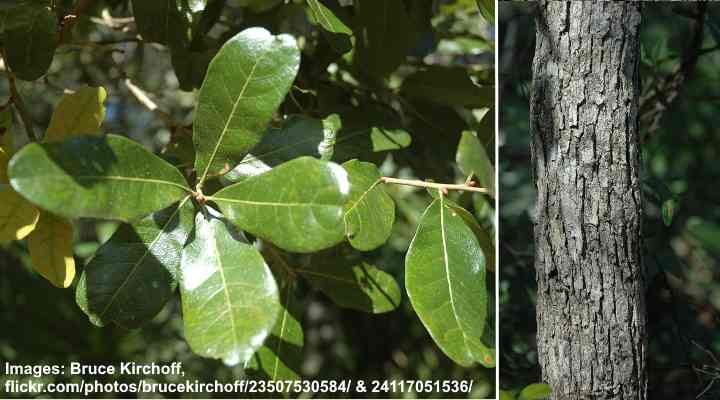
Chapman oak (Quercus chapmanii) leaves and bark
The Chapman oak tree is native to Florida and the southeastern United States. The small, shrub-like oak tree is identified by its grayish-brown scaly bark and oblong leaves with sometimes no lobes, or wavy rounded lobes. Small pairs of brown acorns with gray caps develop in the fall. Chapman oak trees grow no more than 20 ft. (6 m) tall.
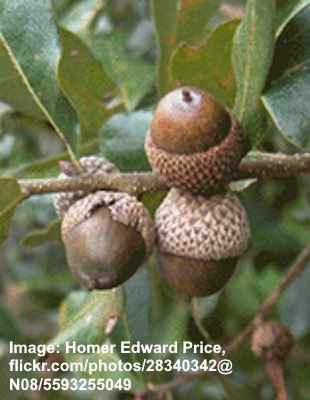
Chapman oak acorns
Oak tree bark: Chapman oak tree bark has scaly plates that are a light gray to pale brown color.
Oak tree leaves: Chapman oak tree leaves are an oblong shape with a rounded apex, and the oak leaves turn yellow or red in the fall.
Myrtle Oak (Quercus myrtifolia)
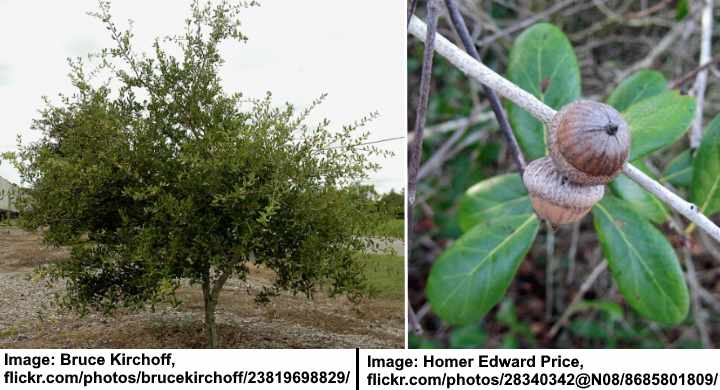
Myrtle oak (Quercus myrtifolia) tree, leaves and acorns
Myrtle oak is a type of scrub oak that grows as a shrub rather than a tree. This evergreen oak shrub is common in Florida, where it grows 40 ft. (12 m) tall, but the small myrtle oak shrub usually grows 15 to 20 ft. (4.5 – 6 m). This oak is identified by obovate or rounded leathery leaves, globular acorns, and a spreading rounded crown.
Oak tree bark: Myrtle oak bark is dark-brown with pronounced furrows and whitish ridges.
Oak tree leaves: Myrtle oak leaves are obovate without any lobes along the margin. The leathery green leaves measure 2” (5 cm) long by 1” (2.5 cm) wide.
Blue Oak (Quercus douglasii)
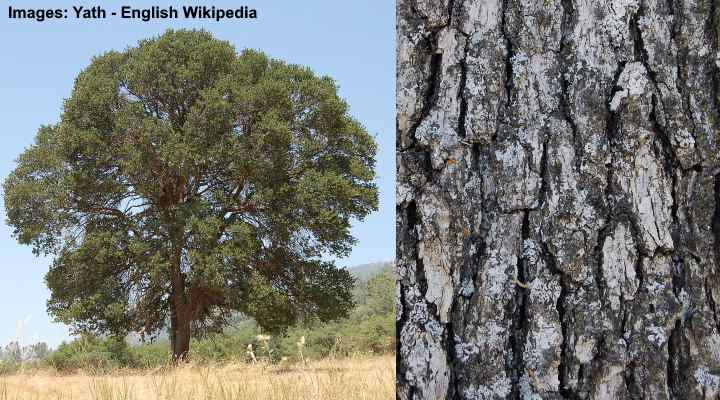
Blue oak (Quercus douglasii) tree and bark
The blue oak is a majestic oak tree native to California. Also called the mountain oak or iron oak, the tree has bluish-green leaves, light gray bark with dark, deep furrows, and sweet, tear-shaped pointed light green acorns. Blue oaks grow 50 to 80 ft. (15 – 24 m) with an irregular crown.
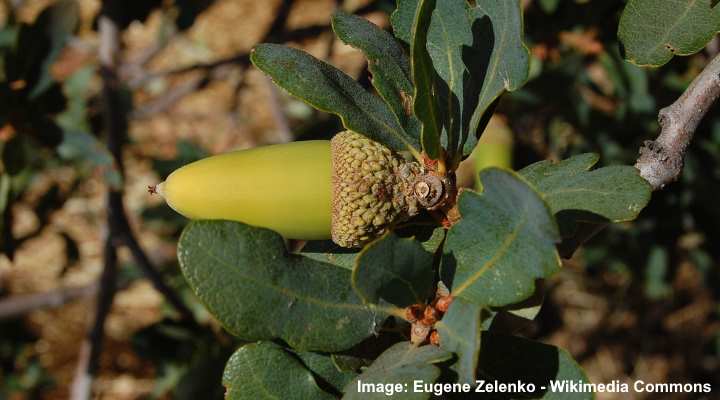
Blue oak acorn and leaves
Oak tree bark: Blue oak bark is relatively thin and flaky and a light gray color.
Oak tree leaves: Blue oak trees have thick, leathery elliptical leaves that may or may not have lobed margins. The leaves measure 1.6” to 4” (4 – 10 cm) long.
Canyon Live Oak (Quercus chrysolepis)

Canyon live oak (Quercus chrysolepis)
The canon live oak is an evergreen oak shrub with a broad, spreading crown, and dense dark-green foliage. Canyon live oaks grow 30 to 80 ft. (9 – 24 m) tall. The shrub is identified by its oblong, pointed leaves, light chestnut-brown acorns, and bushy appearance.
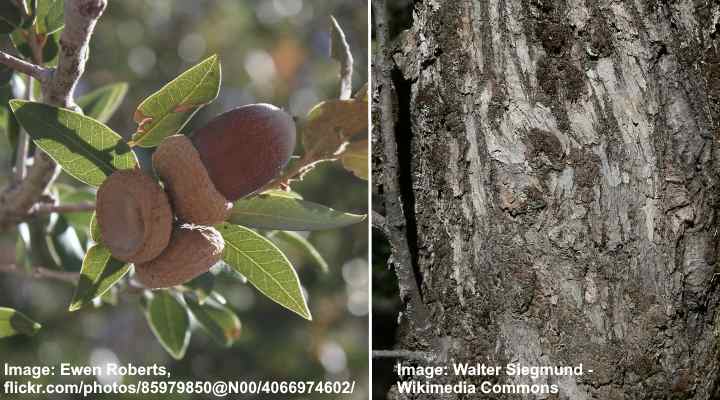
Canyon live oak leaves, acorns and bark
Oak tree bark: Canyon live oak tree light gray bark can be smooth or flaky, and the thicker stems of this multi-stemmed shrub develop deep furrows.
Oak tree leaves: Canyon live oak tree has glossy, leathery lanceolate leaves that are smooth or have spiny teeth along the edges, especially on young branches. The evergreen leaves measure 1” – 3” (2.5 – 8 cm) long and have a distinctive pointed tip and blunt base.

Canyon live oak leaves can have spiny margins on young branches
Texas Oak (Texas Red Oak) (Quercus buckleyi)

Texas red oak (Quercus buckleyi) young trees. Right image: autumn foliage
The Texas red oak is a small to medium-sized deciduous tree native from central Texas to Oklahoma. Identifying features of the stately oak are its obovate leaves with pointed lobes, egg-shaped acorns with a shallow cup, and dark gray bark with furrows on the lower part of the trunk.

Texas red oak leaves
Texas oak trees grow 30 to 50 ft. (9 – 15 m) tall and 60 ft. (18 m) wide. As an attractive ornamental and shade tree, the Texas oak has a rounded crown and dense foliage. Like many oak tree varieties, Texas red oak has stunning fall colors when its lobed leaves turn vivid orange and red colors.
Oak tree bark: Dark gray bark with plate-like scales. On some species, the bark can appear smooth and light gray.
Oak tree leaves: Texas oak tree leaves have five to nine pointed lobes with bristle-tipped teeth. The lobes are distinctly separated by deep sinuses, with the midleaf lobes typically positioned opposite to each other. The upper surface of the leaves is smooth and dark green, while the lower surface appears pale green. The leaves measure 2.4” to 4.8” (6 – 12 cm) long and 2” to 4” (5 – 10 cm) wide.
Nuttall’s Oak (Quercus texana)
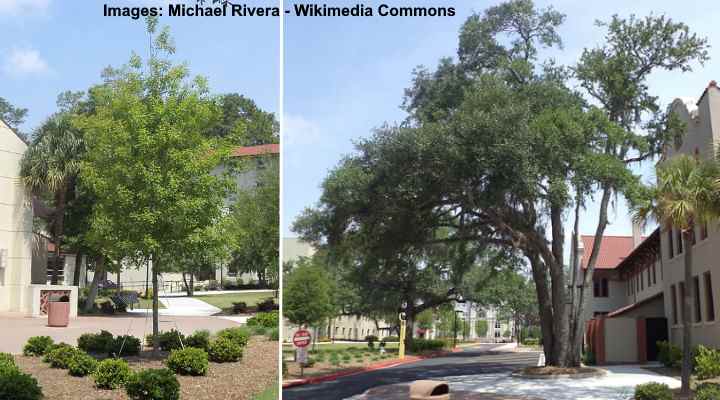
Nuttall’s oak (Quercus texana) young and mature trees
Nuttall’s oak is a deciduous oak tree identified by its wide-spreading rounded crown. With its dark green leaves featuring six to 11 spiny lobes and oval acorns, this native oak makes an excellent shade tree for a landscaping design. The sun-loving oak thrives in moist lowlands but is also tolerant of drought when established.
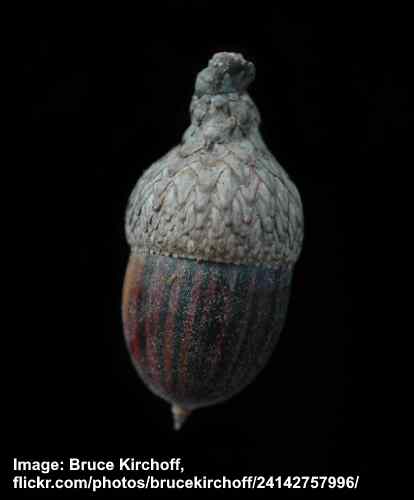
Nuttall’s oak acorn
Nuttall’s Oak offers superb shade and beauty to areas in USDA zones 6 to 9. The stately oak tree grows 40 to 80 ft. (12 – 24 m) tall and 30 to 60 ft. (10 – 20 m) wide. In the fall, Nuttall’s oak turns warm shades of orange, burgundy, and red.
Oak tree bark: The oak tree’s bark is dark brown or gray, featuring flat ridges as the tree matures.
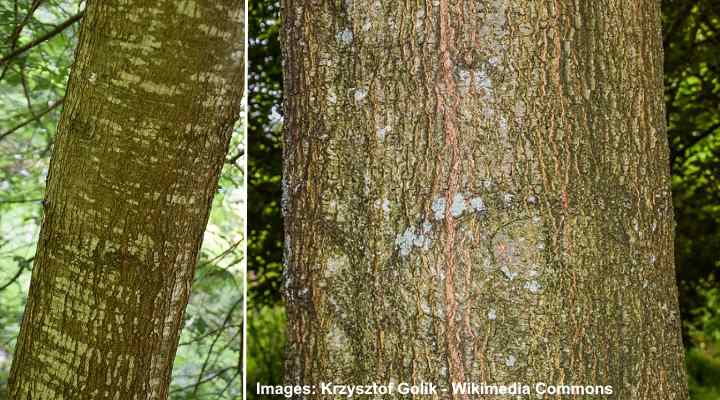
Nuttall’s oak bark
Oak tree leaves: The Nuttall’s oak tree leaves are 3” to 6” (7.5 – 15 cm) long and have a lanceolate shape. They have deeply cut lobes with pointed, spiny tips.
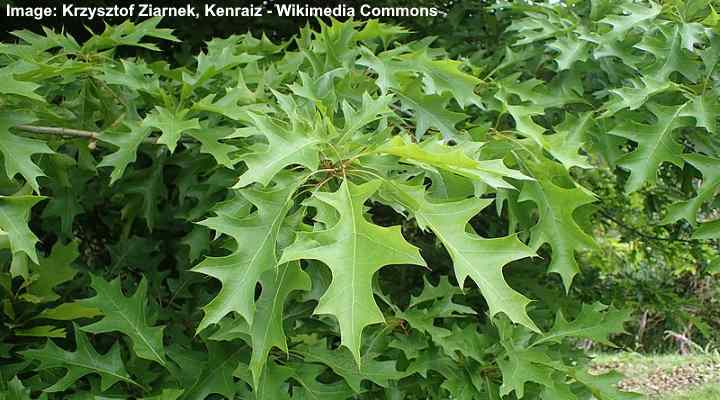
Nuttall’s oak leaves
Mexican White Oak Tree (Quercus polymorpha)
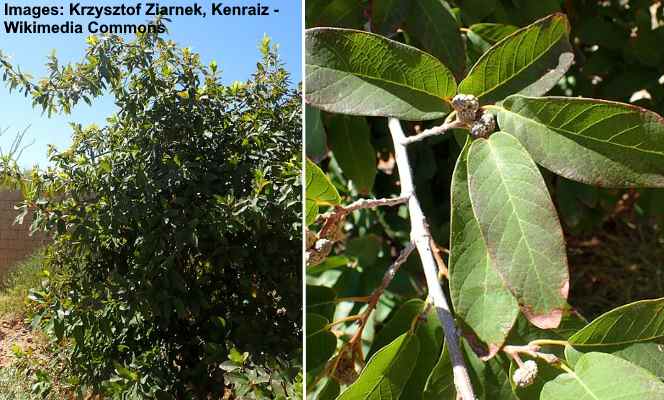
Mexican white oak (Quercus polymorpha) young tree and leaves
The Mexican white oak tree is a striking ornamental oak tree native to the southern United States and Mexico. An identifying characteristic of the oak tree is its oval or egg-shaped leaves without noticeable lobes. In addition, the oak tree has light gray bark and features barrel-shaped acorns growing 1” (2.5 cm) long.
Also called the netleaf oak or Monterrey oak tree, the Mexican white oak grows 40 to 70 ft. (12 – 21 m) tall, and its broad, pyramidal crown measures up to 25 to 50 ft. (7.6 – 15 m). This deciduous oak tree is perfectly suited as a shade tree in urban settings in warmer climates. It thrives in USDA zones 7 to 9.
Oak tree bark: The Mexican oak tree has light to dark gray bark with flaky plates before developing shallow fissures.
Oak tree leaves: The thick, leathery semi-evergreen leaves are lance-shaped with serrated margins and measure 2” to 5” (5 – 13 cm) long.
Mexican Blue Oak (Quercus oblongifolia)
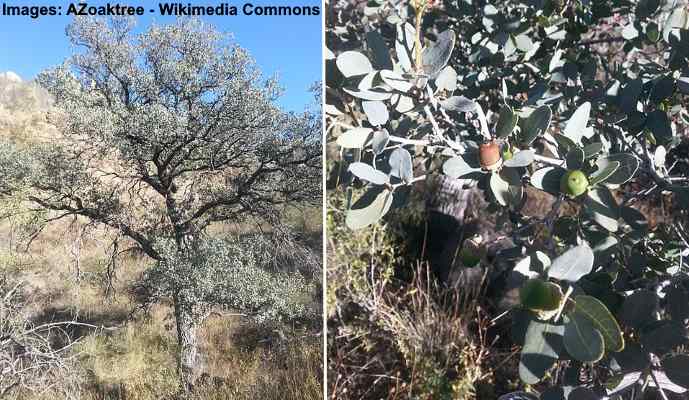
Mexican blue oak (Quercus oblongifolia) tree, leaves and acorns
The Mexican blue oak is a small evergreen tree characterized by deep bluish-green leaves and light-brown egg-shaped acorns. This small shrub-like oak tree has densely furrowed light gray bark with leathery leaves and small clusters of yellowish-green flowers. The small oak thrives in semi-arid locations and tolerates poor, sandy soils.
Also called the Sonoran blue oak or Arizona blue oak, this oak is native to the southwestern United States. The bushy oak grows 16 to 27 ft. (5 – 8 m) tall. The oak tree nuts are small acorns with an oblong shape, measuring 0.75” (2 cm) long. They sit in warty, bowl-shaped caps.
The Mexican blue oak is an ideal landscape choice for both informal and formal settings in arid landscapes. It thrives in high heat and has minimal water requirements.
Oak tree bark: The Mexican blue oak tree bark is identified by its small fissured square plates in a pale gray shade.
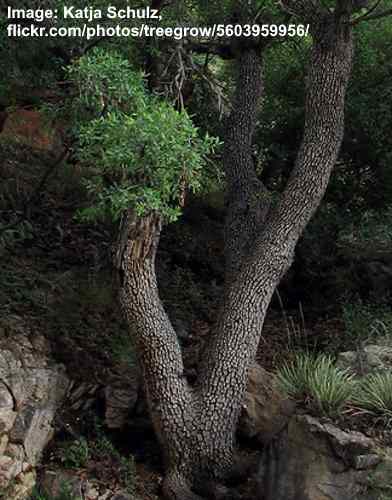
Mexican blue oak bark
Oak tree leaves: Attractive lanceolate leaves with a rounded apex in a deep-blue-green shade on the upper side and mid-green on the underside.
Lacey Oak (Quercus glaucoides)
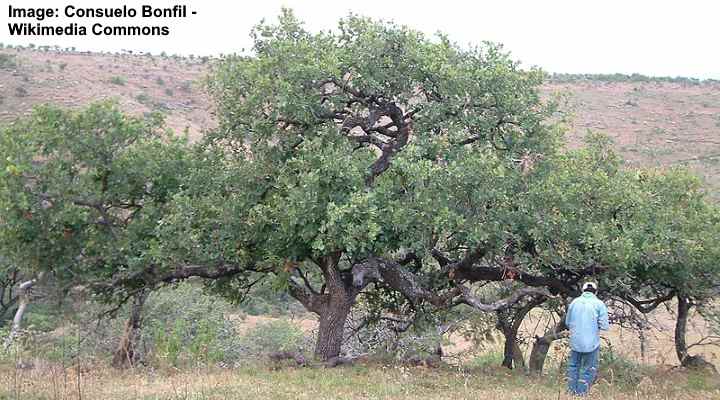
Lacey oak (Quercus glaucoides) tree
The lacey oak is a small to medium-sized tree belonging to the white oak section. The evergreen oak tree has attractive gray-green, thick leathery leaves with shallow rounded lobes. The oak’s barrel-shaped acorns measure 0.75” ( 2 cm) long and sit in a saucer-shaped cap. They typically grow in groups of one to three nuts.
Also called the canyon oak, rock oak, or smoky oak, this deciduous oak grows 20 to 25 ft. (6 – 7.6 m) tall and 15 to 20 ft. (4.5 – 6 m) wide. Its relatively small size and tolerance to heat and drought make it an ideal addition to any garden landscape that gets a lot of daily sunlight.
Oak tree bark: The bark on the lacy oak tree is light gray with scaly ridges and shallow furrows.
Oak tree leaves: The leaves on the lacy oak tree are obovate or elliptical and measure 1.5” to 3.5” (3.8 – 9 cm) long and feature lobed leaves with shallow lobes along the margins. The bluish-green color gives the oak foliage a smoky appearance. Oaks growing in moist soil tend to have deeper lobes.
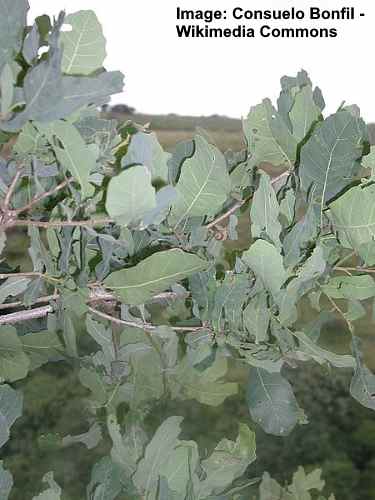
Lacey oak leaves
Graves Oak (Quercus gravesii)
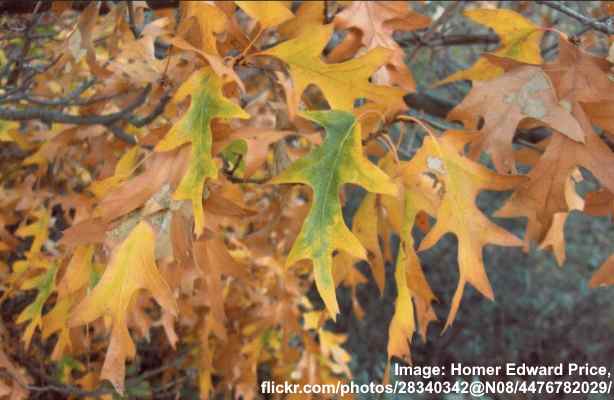
Graves oak (Quercus gravesii) leaves in autumn
The graves oak is a medium-sized oak tree found in Texas, Oklahoma, and Northern Mexico. Identifying features of this deciduous oak are its black bark, dark-green leaves with deep, rounded lobes, and egg-shaped, sometimes round acorns. This uncommon oak tree grows 42 to 50 ft. (13 – 15 m) tall.
Oak tree bark: The bark on graves oak tree is dark grayish black with narrow fissures and flat ridges.
Oak tree leaves: The leaves on the oak tree are glossy green, leathery leaves with three to five triangular lobes, each with a bristle-tipped pointed apex.
Blackjack Oak Tree (Quercus marilandica)
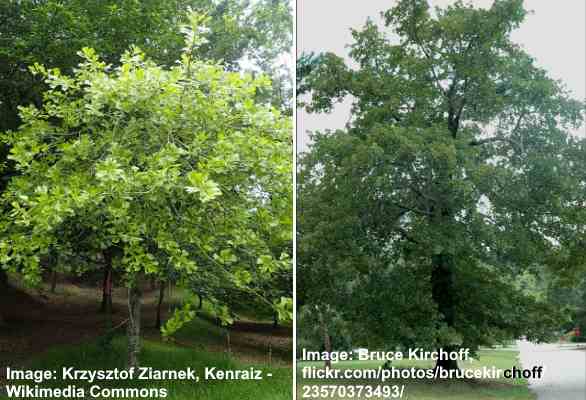
Blackjack oak (Quercus marilandica) young and mature trees
The blackjack oak tree is an attractive small oak tree with deciduous leaves, small acorns, and grayish-black bark. Native to the eastern and central United States, this species of red oak tree thrives in dry, arid landscapes. This branching habit creates a scruffy, irregular crown. The small oak tree grows 20 to 40 ft. (6 – 12 m) tall and wide.
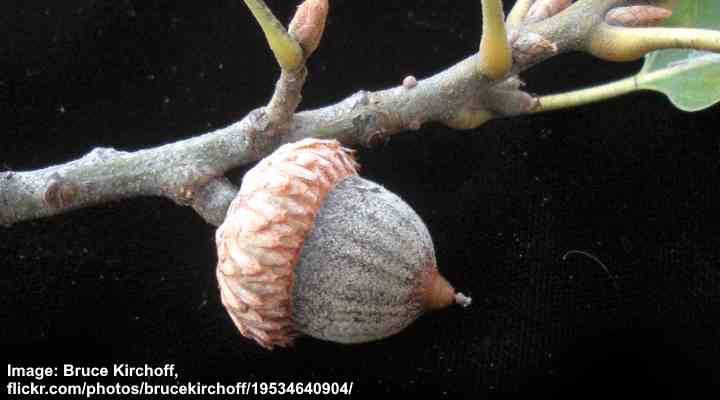
Blackjack oak acorn
The blackjack oak tree thrives in USDA zones 6 to 9. Typical of red oaks, the tree’s foliage has bristle-tipped lobes. Additionally, it has oblong acorns measuring 1” (2.5 cm) long and yellowish-green flower clusters.
Oak tree bark: The bark of the blackjack oak tree is dark gray to black and forms rough plates on the trunk.
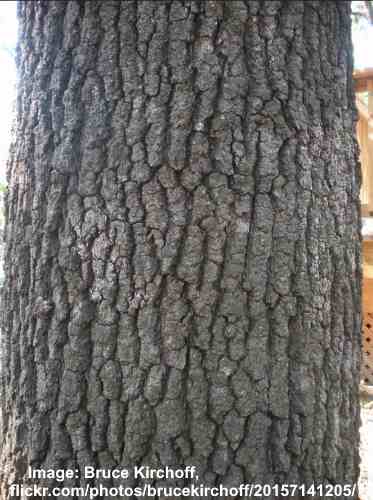
Blackjack oak bark
Oak tree leaves: Leaves on the blackjack oak tree have three to five shallow lobes with bristle tips. The fuzzy oak leaves measure up to 7” (18 cm) long and turn yellow-brown or russet in the fall.

Blackjack oak leaves
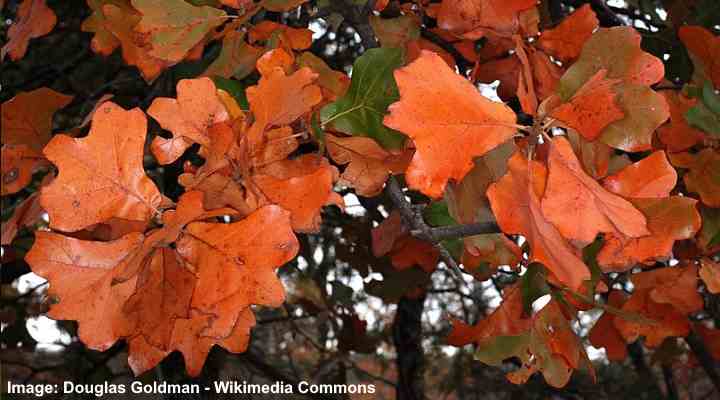
Blackjack oak leaves in autumn
Valley Oak (Quercus lobata)
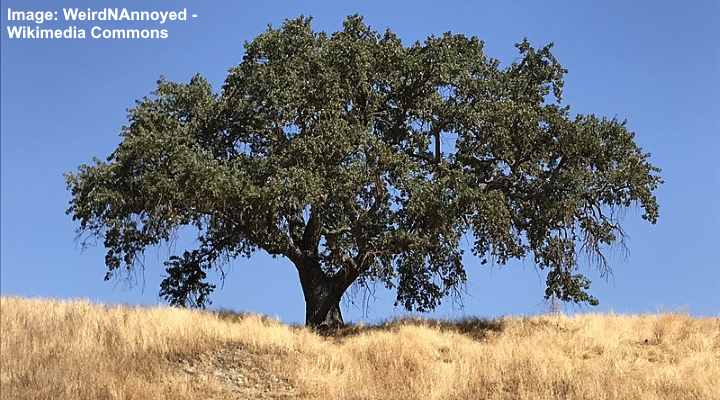
Valley oak tree (Quercus lobata)
One of the largest species of oak is the valley oak. This large, deciduous tree is endemic to California. It grows up to 100 ft. (30 m) and has wide-spreading branches creating a crown 50 ft. (15 m) in diameter. The acorns are medium to dark brown, pointed, and sit in a thick, scaly cup.
Oak tree bark: Valley oak bark is identified by its distinctive ridged bark with small scales resembling alligator skin.
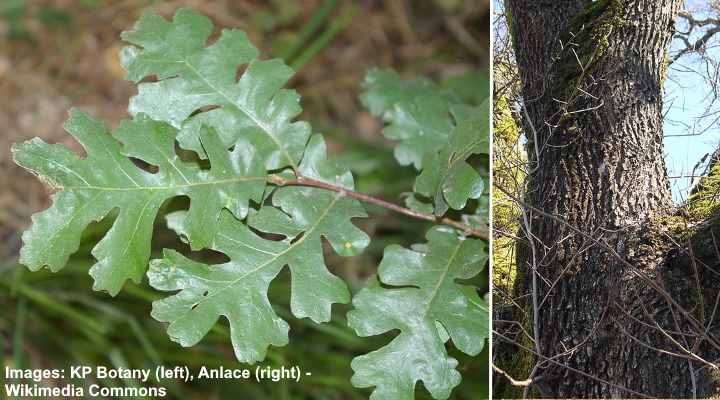
Valley oak leaves and bark
Oak tree leaves: Valley oak leaves measure 2” to 4” (5 – 10 cm) long with round lobes and cuts that almost reach the midrib.
California Scrub Oak (Quercus berberidifolia)
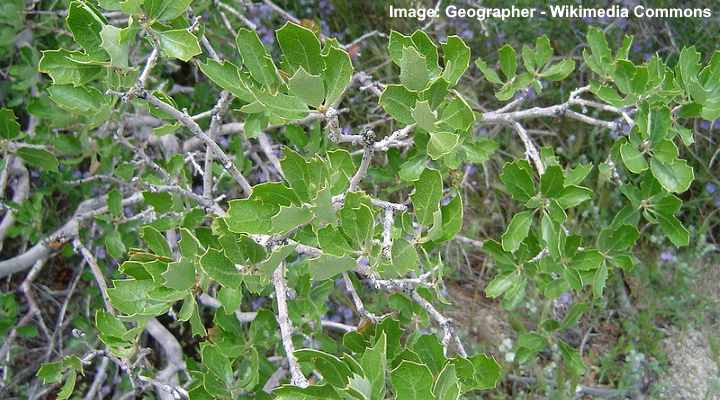
California scrub oak (Quercus berberidifolia) leaves
The California scrub oak is a small, evergreen shrub-like oak tree that grows in the hills of California. The small shrub or tree grows 3.5 to 6.5 ft. (1 – 2 m) tall and is characterized by a twisted trunk and branches. The botanical name of the Canyon live oak means “barberry-leaved,” referring to its jagged leaves.
This species of white oak produces ovoid acorns 1” (2.5 cm) long. In sheltered, warm areas of California, it’s not unusual for the scrub oak to grow up to 13 ft. (4 m) high.
Oak tree bark: The California scrub oak has rough, brownish bark that is thin and flaky.
Oak tree leaves: The California scrub oak leaves are leathery, dull green with sharp spines around the margins. The elliptical to oblong leaves measure 0.60” to 1.20” (1.5 – 3 cm) long. The evergreen foliage drops in dry seasons.
Engelmann Oak (Quercus engelmannii)
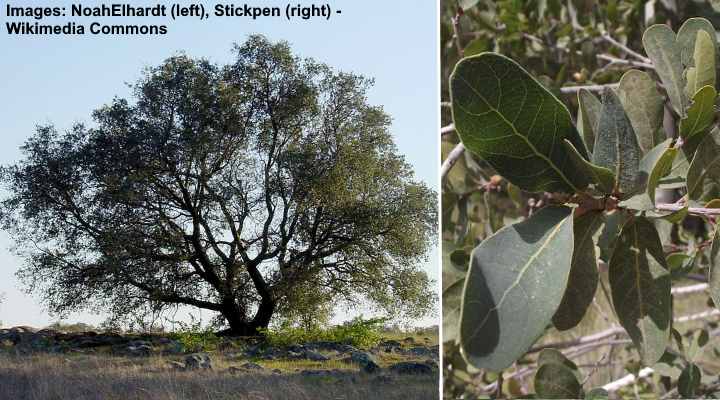
Engelmann oak (Quercus engelmannii) tree and leaves
The Engelmann oak tree is a rare and endangered species of white oak native to Southern California. The relatively small evergreen tree has an open, rounded, irregular crown with spreading branches. The fast-growing oak trees grow 33 ft. (10 m) tall. Its acorns are barrel-shaped, chestnut brown, and sit in scaly cups.
The Engelmann oak tree prefers dry, well-drained soils. In dry seasons, the oak becomes drought-deciduous, meaning they lose their foliage in dry spells. They .
Oak tree bark: Engelmann oak tree bark is grayish-brown, smooth on young trees, and develops deep fissures and ridges as it matures.
Oak tree leaves: Engelmann oak tree leaves are dark bluish-green, leathery, and have wavy, smooth margins. The leaves measure 1.25” to 2.25” (3 – 6 cm) long.
Related articles:
